 Office
Office
2 & 30 International Boulevard
Modern flex-office near Canada’s largest international airport
A prudent person sees trouble coming and ducks.
A simpleton walks in blindly and is clobbered.
— Proverbs 22:3
King Solomon’s words of wisdom have been passed down to us for 3,000 years. They still resonate, especially in this modern translation,1 even though the “trouble” is no longer invading Assyrians or Babylonians but the type of danger we bring on ourselves through an all-too-human combination of ingenuity, hubris and ignorance.
Watch any movie from the 1930s to the 1960s and you will see actors inhaling tobacco smoke with abandon. We know better now. Like the generational awareness of the harm caused by tobacco products, real estate owners have gradually become aware of the dangers lurking in certain building materials and contaminated soil. Starting in the 1960s, societies have spent fortunes cleaning up “miracle products.” Asbestos, PCBs, dry cleaning solvents, herbicides and lead pipes were all considered state-of-the-art technologies at various points in human history. None of these inventions were designed with the intention of killing people. They all started with a noble purpose – whether suppressing catastrophic fires, insulating transformers, cleaning wool suits or producing a pleasing nicotine buzz that also curbed the appetite. The “externalities” associated with societal damage from the use of these products took decades to discover and billions to eradicate.
Greenhouse gas emissions share a common ancestry with these miracle products. Heating buildings with diesel fuels, running gas lines through city streets, producing electricity with coal-fired plants—these were all logical, economical, and sensible solutions to the problem of bringing energy to homes, businesses and buildings of all types. The industrial revolution accelerated the growth of cities and raised the quality of life for millions of people by dragging them out of rural poverty. As we now know, society’s dependence on fossil fuels creates new problems which must be dealt with.
The recognition that miracle products can carry hidden (or not so hidden) dangers follows a predictable pattern. Here is what the step-by-step process often looks like:

Evidence and awareness. An environmental problem often requires decades of scientific study and mountains of evidence to convince people that a change is necessary. Even as this evidence accumulates, vested interests organize counterattacks to convince society that the problem is non-existent or over-stated. Eventually the harm to human life becomes so obvious that denial becomes a “fringe position.”

Market demand. In many cases, the process of partial “market adjustment” can begin ahead of government action. Voluntary data collection and industry-led reforms start the slow process of change. In the case of greenhouse gases, the marginal contribution of each emitter is so small, and so embedded in society, that government interventions sometimes lag market-led shifts (e.g., the adoption of LED lighting or heat pumps).

Regulatory response. Yet, government interventions are almost always needed to accelerate and complete behavioral change to truly eliminate harm to the environment and to human life created by “externalities.” These regulations and policy responses often get pushback as competing outcomes are debated in the political arena. Economists agree that putting a price on carbon would be the most efficient and effective solution, but a market mechanism for carbon pricing requires government intervention — in the form of a carbon “tax” or to set up an emissions trading scheme.

Benchmarks and best practices. Eventually, the rise of data benchmarks and peer group comparisons begins to shed light on who, where and how successful “treatments” are applied to any environmental problem. Engineering and laboratory science helps inform this stage of the process, as does public health or industry group data. Integration with market investment processes and decisions leads to a focus on reversing years of damage to the environment and compliance with new regulations and guidelines. At this stage, market-driven and regulatory-driven changes start to converge.

Price integration. Feedback loops are established where type 1 errors (false positives) and type 2 errors (false negative—or overlooked problems) are exposed.2 In loosely regulated situations like climate change, the efficient market hypothesis (EMH) takes hold as the change process gets partially or fully priced by consumers and producers. Economists and policy analysts favor the practice of placing a “price” on an externality to compensate society for the harm. In practice, though, compensatory payments to offset environmental damage are often decided through the courts and litigation.

Continued market and regulatory evolution. The enforcement of tighter regulations also follows its own trajectory depending on the governance structure of a particular country or urban jurisdiction and the toxicity of the problem. The discipline of epidemiology, using population data and public health analysis, is especially helpful at this stage of refining the policy solutions.
The Transition from “Data” to “Wisdom”
For the de-carbonization of buildings, various markets and countries are well into Step 3 (Regulatory Response) and Step 4 (Benchmarks and Best Practices). In Europe the “theory of change” is focused more on EU-wide or national policies to promote energy disclosures through top-down regulatory solutions. In the United States, the emphasis is based more on voluntary pledges, market solutions and regulations that are based on specific local jurisdictions. In most developed countries, steps 5 (Price Integration) and 6 (Market and Regulatory Evolution) are underway, but both have a long way to go.
The rise of real estate sustainability benchmarks (like GRESB) has accelerated in recent years. In many cases, they have expanded to include social factors and tenant well-being alongside environmental metrics. The next hurdle, though, is to establish materiality tests that infuse meaning, and determine financial impacts based on the volumes of reporting that the industry has started to produce and disclose.
Reading through sustainability reports often reveals the triumph of reporting and public relations over salience or relevance. The conjoint challenges of reducing building emissions alongside improving the well-being of building users and the surrounding communities can be obscured by data denominated in less familiar metrics like tons of CO2 or Kilowatt hours. In time, and with experience, the emphasis will shift to what truly moves the needle on all elements of the “sustainable investing” paradigm—and which metrics give off misleading or meaningless “virtue” signals.
Financial metrics align most closely with the “fiduciary duty” of an investor. Moreover, stakeholders have decades of experience analyzing and interpreting financial data. It will take additional time and effort to convert environmental data into financial terms or to simply raise the consciousness of how to interpret energy and emission data in its own right. (LaSalle’s work on the “Value of Green” synthesizes studies of the evidence linking sustainability metrics and financial outcomes. An update on this work is below.)

In writing Proverbs, King Solomon gathered centuries of wisdom based on experience. In the modern world, we often believe that the steps to wisdom are built on a foundation of knowledge, information, and data. The famous “DIKW” hierarchy has been a mainstay of information sciences since the 1930s. Sustainability wisdom is still in the process of being formulated and likely requires more time to make progress. Fortunately, the foundations of this wisdom are already being put in place—first through data (the modern way to refer to many, many experiences), then information (organized and analyzed data), eventually leading to knowledge (patterns are identified and the “what” and “why” questions are answered) and finally reaching the status of accumulated wisdom (how to respond). This is a path that humans have traveled before. More lives are at stake this time around and the wisdom may not be easily agreed upon by all industries, countries and stakeholders. Nevertheless, the search for sustainability wisdom must continue and time is of the essence.
Revisiting LaSalle’s “Value of Green”
In September 2023, LaSalle published our ISA Focus report What is the value of green? Looking at the evidence linking sustainability and real estate outcomes. The report presents a framework on how sustainable attributes of properties can be viewed as both as drivers and protectors of value, along with showcasing findings from the broader literature. We continue to maintain a Value of Green tracker, monitoring research on this subject as it is produced. Some of the findings that have surfaced since the release of our initial report are worth highlighting:
Beyond the direct links between sustainability and historical investment performance in terms of return, rent and value premiums, more signals are emerging as available data on the topic grows, and becomes increasingly forward looking:
Beyond results based on backward-looking data, detailed case studies of investments into sustainable initiatives are being published. The JLL report “Future-Proof Your Investments“ showcased opportunities for sustainable New York offices; another example is CBRE’s report “The impact of on-site rooftop solar on logistics property values.”

Tobias Lindqvist
Strategist, Climate and Carbon Lead, London
Sources:
CBRE (March 2024) UK Sustainability Index Results to Q4 2023. CBRE
P. Torres, G. Bolino, P. Stepan (2024) The Green Tipping Point. JLL
T.Leahy (2022) London and Paris Offices: Green Premium Emerges. MSCI
P. Torres, J. del Alamo (July 2024) Future-proof your investments. JLL
D. Marina, J. Tromp, T. Vezyridis, O. Bruusgaard (July 2023) The impact of on-site rooftop solar PV on logistics property values. CBRE
O. Muir, Y. Chen, T. Metcalf et.al (Dec 2023) Green premium: Study of New York and London Real Estate finds strong evidence for a ‘green premium’. UBS
What can we learn from simulations?
The de-carbonization of buildings is taking place in a complex and ever-changing environment. It is a multi-dimensional problem replete with uncertain outcomes, regulatory change, shifting societal norms and markets, and the politicization of sensitive issues.
At the June 2024 MIT World Real Estate Forum, Professor Roberto Rigobon unveiled a “sustainability simulation” game patterned on his pathbreaking work on social preferences for the European Commission. The technique shows how the traditional economic conceit that we make “resource trade-offs” does not accurately capture how humans make decisions when faced with multi-dimensional choices.
In the simulation, the audience was given nine choices for different retrofit projects for a commercial building. Each choice resulted in simultaneous movement across three metrics that the audience had already established that they cared about — changes in NOI (profitability), CO2 emissions, and tenant satisfaction/well-being. The cost of the projects was amortized into the NOI calculations and the other metrics were also calibrated based on actual data from the US.
The simulation showed that a knowledgeable real estate audience rarely solves just for “pure profits” at the expense of tenant well-being or CO2 emissions. The simulation also mimicked reality—where sometimes profitability moves in synch with reduced CO2 emissions and other times it moves it moves in the opposite direction. The simulation was designed to show how the co-movement depends on the local market and the type of de-carbonization project. Tenant well-being and CO2 emissions could be implicitly linked to revenue when and if participants believe that occupancy, rents and capital raising are all interconnected.
Through their choices, the audience tried to optimize across all three priorities at once — leading to an interesting result that revealed their average willingness to “pay” to reduce a ton of CO2 emissions of about $200 ton. Yet, if asked directly how much they would pay to reduce a ton of greenhouse gas coming from a building, it seems unlikely that many would have volunteered to pay that much. This finding also shows how the language of profitability and returns is much more advanced than the metrics and concepts associated with either decarbonization or tenant satisfaction. And that all these metrics are linked, but not fully integrated in the minds of real estate professionals.
Only a few participants in the game focused only on reducing CO2 (at the expense of decent profits). And just a few focused exclusively on profitability at the expense of tenant satisfaction or CO2 emissions. This seems like a reasonable facsimile of what enlightened investors will do — especially when they know that their actions are being disclosed. As we learn more from these simulations, it is possible that policy makers will be able to refine the mix of incentives and regulations that govern the real estate industry.
Jacques Gordon
Cambridge, Massachusetts
LOOKING AHEAD >
Footnotes
1 The Message, translated from the Hebrew scriptures by Eugene Peterson (1993-2002).
2 These are all part of the learning that occurs with any “treatment hypothesis.” The science of public health provides solid evidence to weigh whether the “treatment” is helping, hurting or having no impact on the eradication of the underlying disease. In real estate, a good example of this is the gradual discovery that with certain types of asbestos, it is more dangerous to remove it than to “encapsulate” it in an existing structure. The science of “decarbonization” is still being established to determine whether, for example, the mass production of lithium batteries does as much harm as the burning of fossil fuels. For real estate and climate change, the “treatment” will likely focus on energy efficiency/ decarbonization interventions that are a combination of government penalties/incentives and voluntary actions. The effectiveness of these treatments will depend on compliance, market response, and how well interventions find acceptance through the political process.
Important Notice and Disclaimer
This publication does not constitute an offer to sell, or the solicitation of an offer to buy, any securities or any interests in any investment products advised by, or the advisory services of, LaSalle Investment Management (together with its global investment advisory affiliates, “LaSalle”). This publication has been prepared without regard to the specific investment objectives, financial situation or particular needs of recipients and under no circumstances is this publication on its own intended to be, or serve as, investment advice. The discussions set forth in this publication are intended for informational purposes only, do not constitute investment advice and are subject to correction, completion and amendment without notice. Further, nothing herein constitutes legal or tax advice. Prior to making any investment, an investor should consult with its own investment, accounting, legal and tax advisers to independently evaluate the risks, consequences and suitability of that investment.
LaSalle has taken reasonable care to ensure that the information contained in this publication is accurate and has been obtained from reliable sources. Any opinions, forecasts, projections or other statements that are made in this publication are forward-looking statements. Although LaSalle believes that the expectations reflected in such forward-looking statements are reasonable, they do involve a number of assumptions, risks and uncertainties. Accordingly, LaSalle does not make any express or implied representation or warranty, and no responsibility is accepted with respect to the adequacy, accuracy, completeness or reasonableness of the facts, opinions, estimates, forecasts, or other information set out in this publication or any further information, written or oral notice, or other document at any time supplied in connection with this publication. LaSalle does not undertake and is under no obligation to update or keep current the information or content contained in this publication for future events. LaSalle does not accept any liability in negligence or otherwise for any loss or damage suffered by any party resulting from reliance on this publication and nothing contained herein shall be relied upon as a promise or guarantee regarding any future events or performance.
By accepting receipt of this publication, the recipient agrees not to distribute, offer or sell this publication or copies of it and agrees not to make use of the publication other than for its own general information purposes.
Copyright © LaSalle Investment Management 2024. All rights reserved. No part of this document may be reproduced by any means, whether graphically, electronically, mechanically or otherwise howsoever, including without limitation photocopying and recording on magnetic tape, or included in any information store and/or retrieval system without prior written permission of LaSalle Investment Management.
While traditional banks’ appetite for providing commercial real estate loans has declined, other lenders (including investment management firms such as LaSalle) have moved in to fill the funding gap. As a result, we have recently seen increasing interest from institutional investors in real estate debt.
But what is it about real estate debt that makes it a compelling investment? As the second largest of the “four quadrants” of real estate, it has a value in the US and Europe alone of approximately US $4.5 trillion, representing an enormous opportunity. Real estate debt historically has produced competitive risk-adjusted returns in addition to showing low correlation to other assets.
In our latest research, we examine the three-part case for investment, including:
Important notice and disclaimer
This publication does not constitute an offer to sell, or the solicitation of an offer to buy, any securities or any interests in any investment products advised by, or the advisory services of, LaSalle Investment Management (together with its global investment advisory affiliates, “LaSalle”). This publication has been prepared without regard to the specific investment objectives, financial situation or particular needs of recipients and under no circumstances is this publication on its own intended to be, or serve as, investment advice. The discussions set forth in this publication are intended for informational purposes only, do not constitute investment advice and are subject to correction, completion and amendment without notice. Further, nothing herein constitutes legal or tax advice. Prior to making any investment, an investor should consult with its own investment, accounting, legal and tax advisers to independently evaluate the risks, consequences and suitability of that investment.
LaSalle has taken reasonable care to ensure that the information contained in this publication is accurate and has been obtained from reliable sources. Any opinions, forecasts, projections or other statements that are made in this publication are forward-looking statements. Although LaSalle believes that the expectations reflected in such forward-looking statements are reasonable, they do involve a number of assumptions, risks and uncertainties. Accordingly, LaSalle does not make any express or implied representation or warranty, and no responsibility is accepted with respect to the adequacy, accuracy, completeness or reasonableness of the facts, opinions, estimates, forecasts, or other information set out in this publication or any further information, written or oral notice, or other document at any time supplied in connection with this publication. LaSalle does not undertake and is under no obligation to update or keep current the information or content contained in this publication for future events. LaSalle does not accept any liability in negligence or otherwise for any loss or damage suffered by any party resulting from reliance on this publication and nothing contained herein shall be relied upon as a promise or guarantee regarding any future events or performance.
By accepting receipt of this publication, the recipient agrees not to distribute, offer or sell this publication or copies of it and agrees not to make use of the publication other than for its own general information purposes.
Copyright © LaSalle Investment Management 2024. All rights reserved. No part of this document may be reproduced by any means, whether graphically, electronically, mechanically or otherwise howsoever, including without limitation photocopying and recording on magnetic tape, or included in any information store and/or retrieval system without prior written permission of LaSalle Investment Management.
“You take the blue pill—the story ends, you wake up in your bed and believe whatever you want to believe. You take the red pill… all I’m offering is the truth.”
– Morpheus to Neo, The Matrix (1999)
We published the global chapter of the ISA Outlook 2024 on November 14, 2023, just before euphoria about a potential ‘V’-shaped property market turnaround emerged. Interest rates fell quickly as financial markets priced in several US Federal Reserve (Fed) rate cuts in 2024. For a time, it looked as though our prediction that it would take a little longer for markets to digest a renewed spike in rates would not age well.
In this Mid-Year Update, however, we look back to find an outlook with an uncanny resemblance to that of six months ago. This is not because nothing has changed, but because the mood has gone full circle. The landscape remains characterized by interest rate volatility, soft fundamentals in some markets, and gaping quality divides, but also by pockets of considerable strength. Another factor that has not changed is that financial conditions (i.e., interest rates) remain the dominant driver of the market, and that political and geopolitical uncertainties are in focus in many countries (see LaSalle Macro Quarterly, or LMQ, pages 4-6).1
In this report, we discuss five themes we see driving real estate markets for the rest of 2024 and beyond. At our European Investor Summit in May, our colleague Dan Mahoney argued that—like Neo in the Matrix—we should take the red pill and endeavor to see the market as it is, not as we’d like it to be. Taking the red pill requires a realistic view on property values. It reveals as unlikely a return to an environment of ultra-low interest rates or uniformly benign fundamentals in the “winning” sectors.
But it does not mean that there will not be attractive investment opportunities. Unlike the bleak dystopia of The Matrix, there are many reasons for optimism, as well as signs that the coming months will come to be seen as a favorable investment vintage. That said, investing successfully will require a balance of big-picture perspective and granular discernment, and a mix of patience and willingness to take risk.
Over the past year, we likened the interest rate path in most markets to a strenuous mountain trek: the relentless climb (2022), the range-bound altitude of an alpine ridge line (H1 2023), the unexpected upward turn in the trail (Q3 2023), and the mountain meadow of cooling inflation and expected rate cuts (Q1 2024). More recently, there have been upward turns in the interest rates trail whenever there have been signs of sticky inflation in the US and other key countries.

One thing is for sure: No map exists for this trail. While interest rates have big consequences for real estate capital markets, they are extremely difficult to predict. We continue to caution investors against overconfidence in their ability to forecast the path of long-term interest rates.
Mercifully, falling rates are not a necessary condition for a robust recovery in real estate transaction activity. Despite interest rates remaining elevated, property markets are already showing signs of finding their footing, such as renewed US CMBS issuance and resilient deal volumes in many markets and sectors.2 A key reason for this is that wherever interest rates have spiked over the past two and half years, especially Europe and North America,3 real estate prices have by now adjusted downward significantly. The relativities between expected returns for real estate and those for other asset classes now look more appropriate than they have in many months; in other words, more of the market is at or near fair value.4
That said, while lower rates are not necessary for real estate capital market normalization, greater stability in rates than we have been seeing would no doubt help. Interest rate volatility is the enemy of a smoothly functioning private real estate transaction market. Excessive movement in borrowing costs during due diligence periods can lead to dropped deals and re-trades. Moreover, when rates are volatile, the conclusions of fair value models are also volatile, impacting both buyers’ and sellers’ assessments of appropriate pricing. Looking at recent trends in the MOVE index,5,6 interest rate volatility appears to be gradually easing but is still elevated relative to recent history (see LMQ page 13).
Increasing stability in rates is welcome, but for now it is reasonable to expect continued strains in real estate capital markets that create both challenges and opportunities. Such conditions can represent favorable entry points for debt investors (lenders), distressed equity players and core investors seeking entry points below replacement
Over the past half-year, interest rates have been increasingly influenced by widening divergences between near-term growth, inflation and monetary and fiscal policy outlooks. Most notably, the bond yield gap between the US and other markets, especially the eurozone, has widened. US growth and inflation have surprised on the upside, in the face of softening or stability elsewhere. Markets currently expect only one Fed rate cut in 2024, down from up to four earlier in the year.7 Meanwhile, in early June the Bank of Canada became the first G7 central bank to cut rates since the great tightening cycle began, with the European Central Bank (ECB) following shortly after (see LMQ page 7).
Regional groupings can obscure divergences within them. The key driver of eurozone softness is Germany (see LMQ page 23), owing to its reliance on manufacturing exports and past dependance on Russian energy. Meanwhile, the Spanish economy remains strong due to healthy consumption and tourism. Within North America, Canada’s economy is underperforming the US because the structure of its residential mortgage market makes it more exposed to higher rates.8 These intra-regional variations may have a range of impacts on property markets, for example by shifting the relative short-term prospects for demand and value.
Japan and China represent long-standing divergences that persist.9 In China, a loosening bias remains in effect as inflation hovers at around 0%.10 In Japan, monetary policy is gradually normalizing, but so far without triggering a big increase in interest rates (at least compared to elsewhere). In March, the Bank of Japan (BOJ) abandoned negative interest rates and ended most unorthodox monetary policies, though it has since held policy interest rates at around zero. Japan’s economy becoming more “normal” is generally a positive, but interest rate differentials have pushed the yen to a 34-year low against the US dollar (see LMQ page 14), creating upside risks to inflation.11 But notably, Japan remains the one major global market in which real estate leverage remains broadly accretive to going-in yields.
Aside from reinforcing the potential benefits of diversification, what do these divergences mean for investors? Mechanically, any unexpected relative softening of interest rates should, all else equal, be beneficial for relative value assessments of real estate in that market. But firmer rates in the US have predictably come alongside a stronger US dollar. This points to practical limits to global monetary policy divergences; central bankers are keenly aware that weaker currencies come with inflationary risks. Moreover, it is worth asking how persistent macro divergences will be; current divergences are rooted in timing differences of expected rate cuts, rather than an anticipated permanent disconnect.
For several years, secular themes and structural shocks have dominated the trajectories of global property markets. But there is a clear cyclical pattern reemerging in the form of a pronounced upswing in vacancy across global logistics markets, and in US apartments. The return of cyclicality in those favored sectors is having significant impacts on their near-term prospects.
The softening trend is not new. In the ISA Outlook 2024, we identified hot sectors “coming off the boil.” Part of this was down to normalizing demand levels, but elevated new supply was also a key driver. As expected, the softening we observed has continued to deepen, leading to outright rent declines in certain markets, especially for apartments in US sunbelt metros.
Softening fundamentals are not to be ignored, but we recommend investors to have the conviction to “ride the wave” of excess supply. Wide variation in supply levels at the market and submarket level means that investors with granular market data and the discipline to incorporate it into their market targeting processes should be positioned to select the most attractive markets and submarkets.

Moreover, the forces that create cycles sow the seeds of their own reversal; we expect the current supply wave to moderate soon, as evidenced by sharply falling construction starts (see LMQ page 25). Many of the projects being completed today broke ground when credible exit cap rate assumptions were several hundred basis points lower than today. Higher interest rates upended development economics; far fewer new developments can now be justified on today’s mix of land prices, construction costs and financial conditions.
Finally, investors should be prepared to think about cash flows in both real and nominal terms. When cooling nominal rental growth comes alongside cooling inflation, as it does today, it is possible for that to be consistent with solid real rental growth, depending on the relative magnitude of each.
Beyond the reassertion of supply cycles in some markets, there is an evolving mix of secular stories that deserve attention. Some of these are so long-standing that they could almost be considered constants. These include structural shortages of housing in most of Europe, Canada and Australia, as well as the widespread changing definition of core real estate in favor of more operational niche sectors and sub-types.12 We continue to be strong advocates for investment in undersupplied living sectors, and for participating in the institutionalization and growth of niche sub-sectors such as single-family rental (SFR) and industrial outdoor storage (IOS).
More dynamic themes that deserve a closer look include the stabilization of retail real estate and divergent office investment prospects:
Other key secular themes driving investment opportunities today include the implications of artificial intelligence (AI) adoption for data center demand, student mobility for student accommodation in Europe and Australia and aging for senior housing.
Past experience of real estate cycles suggests that the best investment opportunities tend to arise in periods marked by significant uncertainty, volatility and pessimism, but also when early signs of improvement and stabilization are present—in other words, moments similar to today’s environment. Experience also reinforces that it is nearly impossible to time the market, so it is best to be selectively active throughout the cycle. By the time the “all clear” signal is sounded after a market crisis, it is too late to achieve the best risk-adjusted returns.
That said, “red pill” thinking means we must recognize that the coming capital market rebound is unlikely to be as sharp as it was after the Global Financial Crisis (GFC), given that central banks are unlikely to usher in ultra-loose policy. Seeing the market as it is requires accepting the likelihood that interest rates could remain sticky, and a realistic view of near-term fundamentals as a wave of supply impacts some sectors.
Footnotes
1 Also see our ISA Briefing, “Elections everywhere, all at once: Geopolitics and risk”, April 2024. In that note, we highlighted the various sources of political uncertainty this year and outlined how we recommend investors consider these risks. At the time of writing, political developments are particularly salient for short-term movements markets in France and the UK, given elections that have been called in those countries.
2 Source: MSCI Real Capital Analytics and Trepp
3 Japan and China are key exceptions that we cover in greater depth under the “deciphering divergence” header.
4 Of course, there is considerable variation embedded in this and any assessment of fair value. As always, the devil is in the detail on the assumptions that go into expected and required returns; at LaSalle, specific fair value inputs and conclusions remain a proprietary output.
5 The Merrill Lynch Option Volatility Estimate (MOVE) is a market-implied measure of volatility in the market for US Treasuries. It calculates options prices to reflect the expectations of market participants on future volatility. Observation made as of June 24, 2024.
6 Source: Bloomberg as of June 26, 2024.
7 For more discussion of the Canada-US divergence and the consequences of mortgage rate resets, see our ISA Briefing, ”The impact of residential mortgage resets”.
8 For more detailed discussion of the unique factors in the Japanese and Chinese macro environment, see our ISA Briefing, “Key economic questions for China and Japan”.
9 Source: Oxford Economics; Gavekal Dragonomics as of June 26, 2024.
10 Economic theory suggest that weak currency may contribute to inflationary forces because it pushes up the cost of imported goods.
11 See our PREA Quarterly article on “The Changing Definition of Core Real Estate” for a discussion of how the characteristics considered desirable in core properties is moving from traditional metrics like lease length, to observed qualities like the stability of cash flows. This shift elevates the appeal of niche sectors sub-sectors versus traditional sectors such as conventional office.
12 See our ISA Focus report “Revisiting the future of office”, published March 2023.
Important notice and disclaimer
This publication does not constitute an offer to sell, or the solicitation of an offer to buy, any securities or any interests in any investment products advised by, or the advisory services of, LaSalle Investment Management (together with its global investment advisory affiliates, “LaSalle”). This publication has been prepared without regard to the specific investment objectives, financial situation or particular needs of recipients and under no circumstances is this publication on its own intended to be, or serve as, investment advice. The discussions set forth in this publication are intended for informational purposes only, do not constitute investment advice and are subject to correction, completion and amendment without notice. Further, nothing herein constitutes legal or tax advice. Prior to making any investment, an investor should consult with its own investment, accounting, legal and tax advisers to independently evaluate the risks, consequences and suitability of that investment.
LaSalle has taken reasonable care to ensure that the information contained in this publication is accurate and has been obtained from reliable sources. Any opinions, forecasts, projections or other statements that are made in this publication are forward-looking statements. Although LaSalle believes that the expectations reflected in such forward-looking statements are reasonable, they do involve a number of assumptions, risks and uncertainties. Accordingly, LaSalle does not make any express or implied representation or warranty, and no responsibility is accepted with respect to the adequacy, accuracy, completeness or reasonableness of the facts, opinions, estimates, forecasts, or other information set out in this publication or any further information, written or oral notice, or other document at any time supplied in connection with this publication. LaSalle does not undertake and is under no obligation to update or keep current the information or content contained in this publication for future events. LaSalle does not accept any liability in negligence or otherwise for any loss or damage suffered by any party resulting from reliance on this publication and nothing contained herein shall be relied upon as a promise or guarantee regarding any future events or performance.
By accepting receipt of this publication, the recipient agrees not to distribute, offer or sell this publication or copies of it and agrees not to make use of the publication other than for its own general information purposes.
Copyright © LaSalle Investment Management 2024. All rights reserved. No part of this document may be reproduced by any means, whether graphically, electronically, mechanically or otherwise howsoever, including without limitation photocopying and recording on magnetic tape, or included in any information store and/or retrieval system without prior written permission of LaSalle Investment Management.
Report Summary: Physical climate risk data can be a powerful tool for managing asset and portfolio risk and returns. Learn what strategies leading firms are using to manage physical climate risks and navigate market challenges. The latest report from the Urban Land Institute and LaSalle Investment Management builds on their previous report, How to Choose, Use, and Better Understand Climate Risk Analytics, to describe how leading firms are leveraging physical climate-risk data in underwriting practices. With insight into asset- and portfolio-level risk becoming increasingly easy to obtain, new challenges lie in effective interpretation and integration of information into investment practices. Relying on research and interviews with industry leaders, this report provides a nuanced exploration of this emergent issue.
Physical Climate Risks and Underwriting Practices in Assets and Portfolios is structured into three sections, each addressing different aspects of the industry’s response to climate-risk data:
Section 1. Explore the current state of the industry, finding that:
• Leading firms actively coach their teams on physical risk.
• Regulatory trends affect, but do not motivate physical risk assessment.
• Different geographies approach physical with their own level of urgency.
• Investment managers tend to focus on fund risk, capital providers on portfolio risk.
• Tools to understand and price physical risk are still in a nascent stage of development.
Section 2. Examines the application of climate data in decision making. Key findings include:
• Aggregate physical risk is a screening tool; individual hazard risk is actionable information.
• Climate value at risk remains opaque; the utility of the single number offers value but needs increased transparency.
• Atypical hazard risk (e.g., flood in a desert) merits increased attention.
• External consultants can frequently fill skill gaps, especially for firms with less in-house expertise.
• While no predominant timeframe or Representative Concentration Pathway (RCP) emerged as industry standard, the 2030 and 2050 benchmarks were the most commonly referenced time horizon.
Section 3. Assess the impact of physical climate risk on acquisition, underwriting, and disposition practices; finding that:
• Leading firms start with a top-down assessment of physical risk.
• Market concentration of physical risk is analogous to other concentration risks—a nuanced analysis is required.
• Capital expenditure for resilience projections is a key forecast but rife with uncertainty.
• Local-market climate mitigation measures are important to understand but difficult to forecast.
• Exit cap rate discount for estimated physical risk is an increasingly commonly used tool, frequently 25 to 50 basis points.
• Firms infrequently disclose physical risk but the market needs increased transparency.

Important Notice and Disclaimer
This publication does not constitute an offer to sell, or the solicitation of an offer to buy, any securities or any interests in any investment products advised by, or the advisory services of, LaSalle Investment Management (together with its global investment advisory affiliates, “LaSalle”). This publication has been prepared without regard to the specific investment objectives, financial situation or particular needs of recipients and under no circumstances is this publication on its own intended to be, or serve as, investment advice. The discussions set forth in this publication are intended for informational purposes only, do not constitute investment advice and are subject to correction, completion and amendment without notice. Further, nothing herein constitutes legal or tax advice. Prior to making any investment, an investor should consult with its own investment, accounting, legal and tax advisers to independently evaluate the risks, consequences and suitability of that investment.
LaSalle has taken reasonable care to ensure that the information contained in this publication is accurate and has been obtained from reliable sources. Any opinions, forecasts, projections or other statements that are made in this publication are forward-looking statements. Although LaSalle believes that the expectations reflected in such forward-looking statements are reasonable, they do involve a number of assumptions, risks and uncertainties. Accordingly, LaSalle does not make any express or implied representation or warranty, and no responsibility is accepted with respect to the adequacy, accuracy, completeness or reasonableness of the facts, opinions, estimates, forecasts, or other information set out in this publication or any further information, written or oral notice, or other document at any time supplied in connection with this publication. LaSalle does not undertake and is under no obligation to update or keep current the information or content contained in this publication for future events. LaSalle does not accept any liability in negligence or otherwise for any loss or damage suffered by any party resulting from reliance on this publication and nothing contained herein shall be relied upon as a promise or guarantee regarding any future events or performance.
By accepting receipt of this publication, the recipient agrees not to distribute, offer or sell this publication or copies of it and agrees not to make use of the publication other than for its own general information purposes.
Copyright © LaSalle Investment Management 2024. All rights reserved. No part of this document may be reproduced by any means, whether graphically, electronically, mechanically or otherwise howsoever, including without limitation photocopying and recording on magnetic tape, or included in any information store and/or retrieval system without prior written permission of LaSalle Investment Management.
Roughly 60% of the world’s population lives in countries facing major elections in 2024, markets representing 65% of the institutional investable real estate universe.1 Elections are, of course, the cornerstone of the democratic process, which in turn underpins the appeal of the most transparent, investable markets; that said, elections come with the possibility of policy changes that may impact returns. Today’s geopolitical risks, whether they be this continuing election super-cycle (see LaSalle Macro Quarterly, or LMQ, page 4), or the various ongoing conflicts and trade disruptions, prompt important questions about how to manage investment risks related to these themes.
One of the protagonists in the Oscar-winning film Everything Everywhere All at Once says that being “’right’ is a small box invented by people who are afraid.” LaSalle’s risk management philosophy emphasizes optimizing risk/return trade-offs rather than minimizing risk-taking, while recognizing the limitations of point-estimate predictions and base-case scenarios — that is, attempts at “being right.” Today’s geopolitical events are especially likely to confound any forecaster seeking to be exactly right.
How should an investor manage their assets in the context of “unknowables” about which engaging in guesswork is tempting, but being “right” is elusive? What frameworks do we have to mitigate geopolitical risks? We propose six recommendations to keep in mind for investors taking stock of the many elections, and several conflicts, that may impact markets in 2024.
There are many examples of ex ante predictions of elections’ investment implications having been overstated. For instance, leading up to the 2016 US presidential election, there were widespread predictions that the US economy would be significantly negatively impacted by Donald Trump’s anti-immigration and protectionist stance were he elected.2 In the event, equity markets rebounded strongly after a short-lived hit and the US economy proved resilient to the changes in rhetoric and policy that came with a new president.3
Looking ahead to the US elections later this year, almost certainly a rematch between Biden and Trump, coverage of the candidates’ differences should be accompanied by awareness of their similarities. Both candidates seek to prioritize domestic production, which could lead to greater levels of on- or near-shoring of supply chains.4 Moreover, election prediction odds (see LMQ page 6) suggest divided control of the two houses of Congress and the presidency is likely; divided government has typically been associated with relative stability in domestic policy, which is generally positive for markets.5 Both of these factors — at least in isolation — point to the potential for news cycle hype to overstate long-term market impacts of this particular election.
Financial theory tells us that systematic risks are undiversifiable.6 Systematic factors are those with significant, far-reaching implications that affect the price of all assets. But financial theory also entertains that different assets may have different sensitivities to the same set of factors; an asset’s “beta” signifies the responsiveness of its price to a given factor. This is a useful way to think about an investment’s sensitivity to political and geopolitical events. For example, a property in a metro area whose economy is heavily driven by government spending would likely have a high sensitivity to political changes. Another example could be that a property located in the Baltic States, ex-Soviet countries on the border with Russia, is likely to be especially sensitive to developments concerning relations between Russia and the West. Investors should be mindful of assets’ expected sensitivities to geopolitics, whether assessed empirically or, as is more often the case given a lack of data, estimated through intuition.
Systemic risks go beyond systematic factors; they involve severe shocks that have the potential to re-align entire markets in unpredictable ways. An example of such an extreme event is the remote but non-negligible potential that today’s so-called “proxy wars”7 escalate into a broader active conflict between great powers.8 The challenge of incorporating such eventualities into investment decision making is not only estimating appropriate probabilities that such events may occur, but establishing ideal strategic responses should they do so. Catastrophic shocks are exceedingly rare and have the potential to create winners and losers in asset markets that are difficult or impossible to predict.9 It may be more fruitful for investors to focus on more incremental — and more likely — eventualities that have the added benefit of being easier to model.
Media coverage naturally tends to focus on the national and trans-national arenas, but local political developments can be especially impactful for real estate investments. Such issues can fly under the radar, especially given many of the most relevant ones are only of interest to a specialist audience. For example, changes in policy around topics like the planning process, property taxes and transfer taxes (a.k.a. stamp duty) can have direct, measurable and immediate impacts on property cash flows and thus values. The distraction of the bright shiny lights of global geopolitics should not be allowed to excessively overshadow the critical local issues that impact real estate.
To a certain extent, political risks can be managed through diversification. This is especially true when they involve isolated events that impact one country or subnational division such as a specific city, province or state. But often political events are part of a broader arc with potentially far-reaching consequences. A smattering of small seeds can grow from obscurity into a thicket. Nothing illustrates this better than the rise of populism, nationalism and protectionism around the world, themes set to dominate elections this year and beyond. The very notion of “globalized nationalism” may sound like an oxymoron, but it has become a fact.10 While diversification is an essential portfolio construction concept that helps manage many types of risk, including political risk, care must be taken to recognize when what may appear to be “specific” risks are part of a broader pattern that is difficult to “diversify away.”
Geopolitical and political risks are difficult to incorporate into traditional financial analysis. We find that thinking through scenarios can be helpful in identifying investment themes that may emerge from geopolitical trends. These can point to strategies to avoid — as well as potential new ones to pursue. The “Looking Ahead” section of this note expands on some of the key themes we have been tracking.
As geopolitical events are difficult to control and plan for, one may conclude, similarly to that same protagonist in the Everything Everywhere film, that “nothing matters.” But uncertainty is no excuse for ignoring geopolitical risks. We do stop short of directly feeding geopolitical themes into our formal risk management program, where the focus is on the specific risks that can actively be managed for our clients.11 However, it remains important to observe and understand macro conditions from a holistic perspective. The work done in our regional research teams — particularly that focused on capital markets, the signals that foreshadow potential inflection points and the local political themes that impact real estate — is critical to this effort.
We have argued that political and geopolitical risks are difficult to incorporate into investment processes, but that considering “what ifs” can be useful in uncovering relevant investment themes. Below are three potential real estate implications of the current geopolitical backdrop that we are monitoring today:
Footnotes
1 LaSalle analysis of data from Time and our proprietary investable universe estimates. See LMQ page 5 for more detail.
2 Sources: “What do financial markets think of the 2016 election?” Brookings Institution paper, Wolfers and Zitzewitz, 2016. The article predicted that “a Trump victory would trigger an 8-10% sell-off”. See also “The Consequences of a Trump Shock,” a Project Syndicate article by Simon Johnson, 2016. He predicted Trump’s election would “likely cause the stock market to crash and plunge the world into recession.”
3 On the news of the 2016 election result, Standard & Poor’s 500-stock index initially fell 5% but ended the day up more than 1%, according to Refinitiv. The US avoided a recession until the emergence of the COVID-19 pandemic, according to Oxford Economics.
4 Source: “Biden vs Trump: Key policy implications of either presidency,” Economist Intelligence Unit, 2023.
5 Sources: “What to Expect From Divided Government.” PIMCO article, Cantrill, 2022. According to the article, “the equity markets historically have tended to do well in years of split government.”
6 Source: The Handbook of Risk Management: Implementing a Post-Crisis Corporate Culture. P. Carrel, 2012. “Systematic or market risk refers to the inherent danger present throughout the entire market that cannot be mitigated by diversifying your portfolio. Broad market risks include recessions, periods of economic weakness, wars, rising or stagnating interest rates, fluctuations in currencies or commodity prices, and other ‘big-picture’ issues like climate change. Systematic risk is embedded in the market’s overall performance and cannot be eliminated simply by diversifying assets.”
7 According to the Oxford Dictionary, “proxy wars are the replacement for states and non-state actors seeking to further their own strategic goals yet at the same time avoid engaging in direct, costly, warfare.” Various observers have argued that the Russia-Ukraine and Israel-Gaza conflicts are proxy wars. For example, see “IKs the ware in Ukraine a proxy conflict?” Kings College London report, Hugues (2022).
8 According to a research brief by RAND: “Great power wars — conflicts that involve two or more of the most powerful states in the international system. These have historically been among the most consequential international events.”
9 Source: “What a third world war would mean for investors,” The Economist, 2023. The article highlights the virtual impossibility of positioning an investment portfolio to outperform through prior world wars, even if the investor had correctly predicted that these conflicts would occur.
10 For further discussion of the global spread of nationalism, see “How cynical leaders are whipping up nationalism to win and abuse power”, The Economist, 2023; “Demonizing nationalist parties has not stemmed their rise in Europe,” The Economist, 2022; “The new nationalism,” The Economist, 2016.
11 We do, however, utilize tools that correlate to geopolitical risk. For example, the JLL Global Real Estate Transparency Index (GRETI) supports our monitoring of evolving investment conditions around the globe. Whilst the model does not explicitly consider political risk, the two are inexplicably linked through the inclusion of a number of governance and regulation data points.
12 Source: “A global economic policy uncertainty index from principal component analysis,” Finance Research Letters, Peng-Fei Dai, 2019.
13 Source: “What are the impacts of the Red Sea shipping crisis,” J.P. Morgan, 2024.
14 Source: “The Great Rewiring: How Global Supply Chains Are Reacting to Today’s Geopolitics,” Center for Strategic & International Studies, 2022.
15 Sources: “The business costs of supply chain disruption,” Economist Intelligence Unit, 2021 and “Why Deglobalization Makes US Inflation Worse,” Project Syndicate, Moyo, 2022.
This publication does not constitute an offer to sell, or the solicitation of an offer to buy, any securities or any interests in any investment products advised by, or the advisory services of, LaSalle Investment Management (together with its global investment advisory affiliates, “LaSalle”). This publication has been prepared without regard to the specific investment objectives, financial situation or particular needs of recipients and under no circumstances is this publication on its own intended to be, or serve as, investment advice. The discussions set forth in this publication are intended for informational purposes only, do not constitute investment advice and are subject to correction, completion and amendment without notice. Further, nothing herein constitutes legal or tax advice. Prior to making any investment, an investor should consult with its own investment, accounting, legal and tax advisers to independently evaluate the risks, consequences and suitability of that investment.
LaSalle has taken reasonable care to ensure that the information contained in this publication is accurate and has been obtained from reliable sources. Any opinions, forecasts, projections or other statements that are made in this publication are forward-looking statements. Although LaSalle believes that the expectations reflected in such forward-looking statements are reasonable, they do involve a number of assumptions, risks and uncertainties. Accordingly, LaSalle does not make any express or implied representation or warranty, and no responsibility is accepted with respect to the adequacy, accuracy, completeness or reasonableness of the facts, opinions, estimates, forecasts, or other information set out in this publication or any further information, written or oral notice, or other document at any time supplied in connection with this publication. LaSalle does not undertake and is under no obligation to update or keep current the information or content contained in this publication for future events. LaSalle does not accept any liability in negligence or otherwise for any loss or damage suffered by any party resulting from reliance on this publication and nothing contained herein shall be relied upon as a promise or guarantee regarding any future events or performance.
By accepting receipt of this publication, the recipient agrees not to distribute, offer or sell this publication or copies of it and agrees not to make use of the publication other than for its own general information purposes.
Copyright © LaSalle Investment Management 2024. All rights reserved. No part of this document may be reproduced by any means, whether graphically, electronically, mechanically or otherwise howsoever, including without limitation photocopying and recording on magnetic tape, or included in any information store and/or retrieval system without prior written permission of LaSalle Investment Management.
Purpose-built student accommodation (PBSA) in Europe ranks as one of our top-conviction sectors for investment in the coming years. No longer deserving of the “niche” label in the United Kingdom, it is already more institutional than any other type of living sectors property in the country and is rapidly maturing in Continental Europe as well. The rise of student accommodation on investors’ buy lists is for good reason. This ISA Briefing will set out why that is so and discuss how the sector stands out in Europe compared with student housing in the rest of the world.
After a brief, pandemic-induced interruption, in-person learning in Europe is back with more students enrolled than at any point in history. Higher education participation rates in the European Union have steadily risen across recent years, reaching an all-time high of 36% for 20-24 year-olds1 in 2021/22, with the same proportion recorded for the UK in 2023.2 A total of 18.5 million students were studying in the EU as of the 2021/22 academic year, with a further 2.9 million in the UK, having grown by 8% and 20%, respectively, over the previous five years.3
Demand for PBSA varies by profile of student. While domestic students are still crucial as a source of demand, particularly in markets where few students commute from home to study, international students are far more likely to reside in PBSA than domestic students (60% more likely to do so in the UK, as an example4). As shown in the chart below, international student mobility has been on a clear growth trend in recent years, with 2021/22 seeing a record number of foreign students in the EU and UK. European students studying outside their home countries elsewhere in Europe is a longstanding feature of the market, facilitated by freedom of movement within the EU, well-established student exchange programs, the rise of English-language courses and Europe’s dense geography.
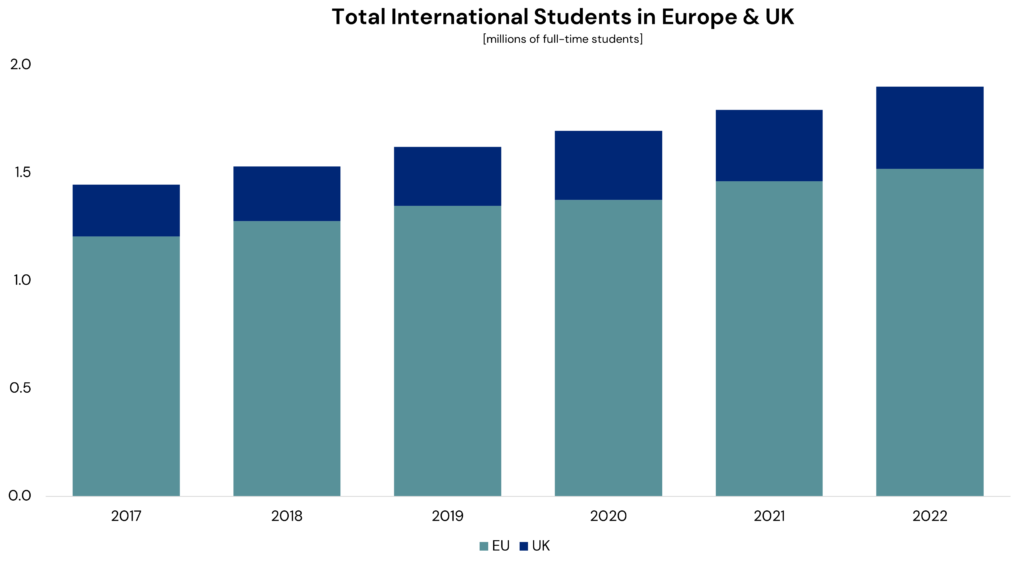
A key driver of growth has been students from outside Europe. Europe has an outsized number of highly ranked universities relative to its size,5 a prevalence of English-language courses (which are increasingly no longer limited to the UK and Ireland) at a comparatively cheaper cost of tuition and living compared to North America.6 These attributes taken together can explain the sharp rise in non-EU students studying in the bloc, whose numbers have grown 31% since 2016.7 In the UK, the growth has been even faster, at 59% over the same period.8
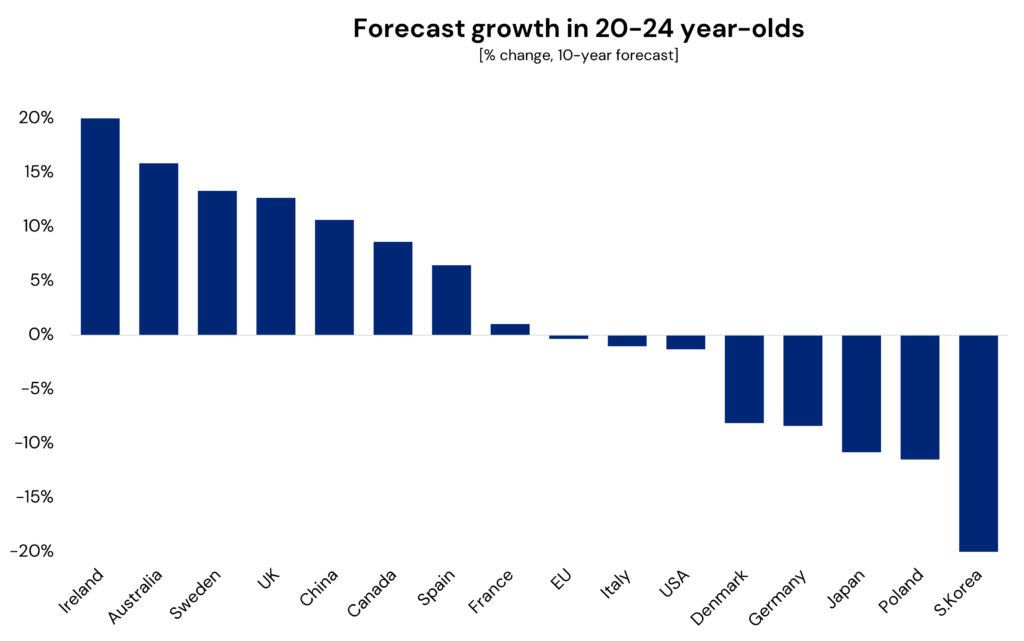
That said, there are demand-side risks to be mindful of. The demographic outlook for Europe is mixed; forecasts for some countries such as the UK, Spain and Sweden show a demographic ‘bump,’ with the number of university-aged people growing ahead of national population levels. However, in other nations, numbers are forecast to be broadly flat (France) or negative (Germany and the Netherlands). This suggests uneven growth in demand for higher education going forward.9
This mixed demographic outlook will mean greater reliance on international student demand, but there are tentative signs that may also be facing some headwinds. A recent policy change in the UK has removed the right to visas for international students’ family members.10 For now, this change represents tinkering around the edges and is unlikely to have a major impact on demand. It does, however, indicate a directional change in policy aimed at restricting overseas student numbers, presumably in a bid to bring down immigration figures. Such policy changes may incrementally dissuade would-be foreign students from studying in the UK, though demand may shift elsewhere, potentially to the benefit of other European countries. Despite such risk factors, the overriding view is one of positivity for higher education demand in Europe and therefore PBSA.
European student housing should be viewed within the wider context of the region’s housing market. Europe is currently facing a long-term, persistent housing shortage. Housing scarcity is not limited to major gateway cities, but is also the reality within mid-sized cities and even smaller university towns. Since 2010, Europe has built homes at a rate only 40% below pre-GFC levels,11 contributing to rising rents, increasing house-price-to-income ratios and worsening access to suitable housing. Demand for rental housing in cities remains robust, supported by long-term trends of immigration, urbanization and declining home ownership rates; as such, the imbalance between supply and demand is now fully entrenched.12
Students are, like all participants in the housing market, at the mercy of housing supply and demand. Shortages have fed through to the student market, with students finding accommodation increasingly unaffordable. Over the past two years, this has led to sharp growth in PBSA rents, with several UK cities reporting year-over-year growth in the high teens for 2023, and other markets experiencing growth well ahead of previous levels.13 The lack of supply is also leading to students being housed increasingly in unsuitable conditions; stories from the UK of students living in hotels or in completely different cities over an hour travel from campus are a clear symptom of insufficient student housing stock.
New investment in the sector should contribute to resolving the imbalance, but it will be a major challenge to fully close the wide gap between supply and demand. While there are nuances between markets, rising construction and development financing costs are making the delivery of new schemes less economical, evidenced by a sharp decline in the number of residential permits issued in several countries over the past year.14 Furthermore, restrictive planning laws and burdensome safety regulations are lengthening the time it takes for projects to be realized.
These factors inform our positive outlook on the rental housing market in Europe, which carries over into PBSA. The imbalance between supply and demand will likely persist and even worsen, driving very low vacancy and supporting strong rental growth for owners of residential and student housing real estate, or those who can deliver new schemes in those sectors.
Regulations in Europe can act as a handbrake for residential rents, as we set out in our ISA Briefing, Controlling Interest: Keeping tabs on residential regulations. In nearly all continental European rental markets, rents cannot be increased annually at the landlord’s discretion, with rental levels for in-place tenants typically linked to a backward-looking index. During the recent ‘great reflation’ period, this has meant income from many rented residential properties did not keep pace with inflation. But student housing stands out from more traditional rental housing investments as having a cash flow profile far less impacted by the growth-muting tendencies of regulation.
In part, this is because PBSA often faces less regulation or stands outside of regulatory systems altogether. Students’ nature as transient, temporary residents means that their needs are rarely prioritized by local politicians, particularly compared to those of permanent residents. They typically only stay in a city for a few years, do not have dependents and their rental obligations often come with implicit or explicit parental guarantees. This means that PBSA is targeted for rent controls far less often than the wider rental market. Moreover, zoning and classifications for student accommodation are often distinct from standard rental housing, exempting it from regulations that limit absolute rent levels or restrict annual rental increases. Moreover, regulatory requirements on minimum unit sizes or lease lengths usually do not apply.
Even where regulated, PBSA benefits from its relatively short duration of tenancy. Given the vast majority of students study for 3-4 years, there is far greater annual turnover of tenants compared with the wider residential market. Faster turnover allows for landlords to more effectively mark rents to market levels. This means PBSA rents may better keep pace with inflation, even in jurisdictions where regulations do apply to the sector.
The increased maturity of student accommodation is another factor in its favor. The UK is clearly ahead of the rest of Europe in this regard, with a deep, liquid investment market, publicly traded REITs and a large number of established specialist operators. The sector’s wide acceptance from both tenants and investors means that we would consider it a ‘Core’ sector on our ‘going mainstream’ framework, as detailed in our ISA Portfolio View. Elsewhere in Europe the sector is considered more niche, but its growing acceptance means we would consider it ‘Near-Core’ on the same framework. Investment figures support the observation of a varying level of maturity for the sector—UK PBSA has made up 66% of investment volumes annual on average since 2014, despite the EU having 6.4 times the number of students.15
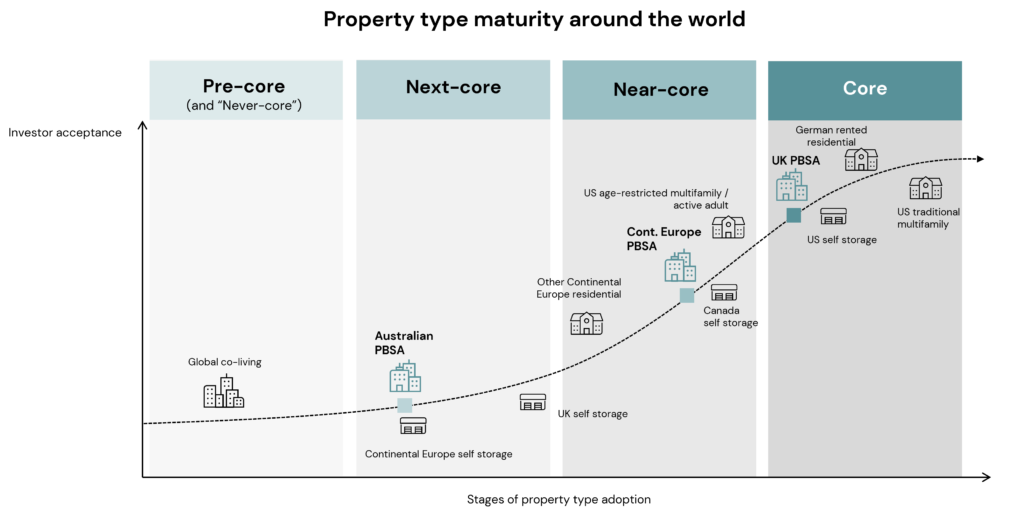
Over time, we expect this to change; the opportunity for investors to take advantage of the structural trends outlined above is likely to drive increased investment in the sector. Countries like as Spain or Italy have PBSA provision rates16 of below 10%, compared to more than 30% in some major UK markets,17 suggesting there is significant scope for delivery of new supply. Cities such as Milan, Madrid and Barcelona all have student populations of over 100,000 and multiple well-ranked institutions, giving them diverse demand bases and making them likely to be key growth markets for the sector in the coming years.
As niche sectors mature, greater liquidity and investor acceptance tends to lead to any yield premium they offer versus traditional sectors narrowing, as investors require less compensation for liquidity and transparency risks; such a pattern has already been observed in UK PBSA. This potential narrowing of yields in European markets is another factor behind our conviction that the sector is likely to offer attractive returns.
Student accommodation in much of Asia Pacific is still in a nascent stage, with relatively limited PBSA stock, few specialized operators and comparatively little institutional investment. The major exception in the region is Australia, which has characteristics similar to those of the sector in Europe and the UK, but is a number of years behind in its evolution. This suggests a similar path to maturity may lie ahead. Like Europe, Australia benefits from English-language courses at comparatively lower tuition costs than the US, while also offering post-study work visas. As a result, it has an even higher proportion of international students than most major European countries.18 Still, the Australian PBSA sector remains in its infancy as an investable property type. Stock numbers are low even compared to the most immature countries in Europe, with a student-to-bed ratios of 16-to-119 and significantly higher than the UK where it is around 3-to-1.
Traditionally, international students in Australia tap into private rental housing for accommodation. Both the private rental market and the PBSA sector in Australia have experienced tight occupier market fundamentals and experienced double-digit rental growth over the past two years.20 The solid performance has been primarily driven by strong migrant inflows, including international students, as well as high interest rates that encourage Australians to rent rather than buy, and relatively limited existing stock and new supply of all types of housing.
The United States, by contrast, has a more established student housing sector, but our view of the property type there is less favorable as compared to other regions. For a start, the demographics are less favorable given the population of 18-to-24 year-olds in the US is forecast to decline through 203321 and enrollment rates at 4-year institutions have remained roughly flat since 2010.22
An additional point of difference between US and European universities is their locations. Many top-tier US universities are in small cities in which a single school dominates the population and economy. Student housing properties in these markets are dependent on a single source of demand that controls enrollment growth and housing policy. Additionally, barriers to new supply are generally lower compared to major European cities, which allows for more new development to come in and disrupt the market. Taken together, these factors mean rent trends in these markets can be volatile. While there are similar university-centric towns in Europe, our investment focus is on the larger markets, where housing markets are tightest and there is a diverse demand base from multiple universities.
Footnotes
1 Source: Eurostat
2 Source: Higher Education Statistics Agency (UK)
3 Source: Eurostat, Higher Education Statistics Agency (UK)
4 Source: Savills
5 The number of European universities in the top 2000 spots Center for World University Rankings (CWUR) league tables per capita is the highest of any world region, according to data from CWUR, Oxford Economics, and analysis by LaSalle.
6 Source: Educationdata.org
7 Source: Eurostat
8 Source: HESA
9 Assuming no change in the propensity of people in that age cohort to attend university.
10 UK Government introduced policy on January 1st 2024
11 Source: European Central Bank
12 For deeper analysis of European housing markets and the underlying supply imbalance see LaSalle’s ISA Outlook 2024.
13 Source: JLL
14 LaSalle analysis of data taken from the national statistics agencies of major European countries (Germany, UK, France, Spain, Sweden, Denmark, Finland, Italy, Portugal, Netherlands, Ireland)
15 Source: MSCI Real Capital Analytics
16 Metric defined as number of purpose-built student beds as a share of total enrolled population of students in higher education.
17 Source: JLL
18 Source: UNESCO
19 Source: CBRE
20 Source: SQM Research (for private rental market), as of November 2023; CBRE (for PBSA), as of August 2023
21 Source: Oxford Economics
22 Source: National Center for Education Statistics (US)
Important Notice and Disclaimer
This publication does not constitute an offer to sell, or the solicitation of an offer to buy, any securities or any interests in any investment products advised by, or the advisory services of, LaSalle Investment Management (together with its global investment advisory affiliates, “LaSalle”). This publication has been prepared without regard to the specific investment objectives, financial situation or particular needs of recipients and under no circumstances is this publication on its own intended to be, or serve as, investment advice. The discussions set forth in this publication are intended for informational purposes only, do not constitute investment advice and are subject to correction, completion and amendment without notice. Further, nothing herein constitutes legal or tax advice. Prior to making any investment, an investor should consult with its own investment, accounting, legal and tax advisers to independently evaluate the risks, consequences and suitability of that investment.
LaSalle has taken reasonable care to ensure that the information contained in this publication is accurate and has been obtained from reliable sources. Any opinions, forecasts, projections or other statements that are made in this publication are forward-looking statements. Although LaSalle believes that the expectations reflected in such forward-looking statements are reasonable, they do involve a number of assumptions, risks and uncertainties. Accordingly, LaSalle does not make any express or implied representation or warranty, and no responsibility is accepted with respect to the adequacy, accuracy, completeness or reasonableness of the facts, opinions, estimates, forecasts, or other information set out in this publication or any further information, written or oral notice, or other document at any time supplied in connection with this publication. LaSalle does not undertake and is under no obligation to update or keep current the information or content contained in this publication for future events. LaSalle does not accept any liability in negligence or otherwise for any loss or damage suffered by any party resulting from reliance on this publication and nothing contained herein shall be relied upon as a promise or guarantee regarding any future events or performance.
By accepting receipt of this publication, the recipient agrees not to distribute, offer or sell this publication or copies of it and agrees not to make use of the publication other than for its own general information purposes.
Copyright © LaSalle Investment Management 2024. All rights reserved. No part of this document may be reproduced by any means, whether graphically, electronically, mechanically or otherwise howsoever, including without limitation photocopying and recording on magnetic tape, or included in any information store and/or retrieval system without prior written permission of LaSalle Investment Management.
FOR INTENDED INSTITUTIONAL INVESTORS ONLY – NOT FOR GENERAL PUBLIC DISTRIBUTION
LaSalle manages both closed-end funds and separate accounts that seek to provide attractive risk-adjusted returns in Canadian real estate.
0
closed-end vehicles
0+
years of experience
0+
transactions
$ 0b
transaction volume
Assets in Canadian dollars; data as of December 31, 2024; returns may increase or decrease as a result of exchange rate fluctuation.
The value-add strategy is focused on investing in assets that have significant potential for value creation, has a moderate exposure to ground-up development and a flexible approach to reposition-to-sell and build-to-core strategies. The team has successfully closed six previous vehicles and has 20+ years of experience across property sectors in major Canadian markets.

Canada is of the few AAA sovereign markets with a sizable and transparent real estate market. G7 leading population growth, a highly educated workforce and a service-oriented economy all point to continued demand.

The value-add team in Canada focuses on building diversified portfolios of assets where user demand is strongest but supply is insufficient. The team is also able to pivot with changing market conditions.

LaSalle’s Canadian asset management team drives returns in our portfolio of assets. By identifying opportunities for value creation and execution, the team seeks to manage downside risk and aims to realize income and value for investors.

The ability to harness and synthesize information is key to the success of the Canadian value-add team. They regularly draw on the expertise of LaSalle’s data-driven, in-house Research and Strategy team, who are actively involved in advising on strategy and investment decisions.
For a full description of the risks associated with investing in any opportunity, please refer to the “Summary of Risks” in the relevant offering memorandum.

LaSalle recognizes that sustainability factors, when properly applied, can positively influence investment performance. We tailor our approach to each fund and each asset, working to protect and enhance financial returns today and in the future. We are proud to have achieved a score of A+ from the UN PRI for both strategy and governance and property. We have also committed to being a net zero carbon firm by 2050.
By working to improve energy efficiency, lower emissions and capture resources such as sunlight and rainwater, we’re improving performance today and building a better tomorrow.
 Office
Office
2 & 30 International Boulevard
Modern flex-office near Canada’s largest international airport
 Residential
Residential
East York Apartments
Toronto multifamily complex
 Retail
Retail
Mission Junction Shopping Centre
A dominant grocery-anchored shopping center in Mission, British Columbia
 Industrial
Industrial
Southern Ontario Industrial Portfolio
Six industrial assets across southern Ontario
 Industrial
Industrial
Toronto Airport Mid-Bay Industrial Portfolio
An eight-building portfolio near Pearson International Airport



Important information
This webpage is for informational purposes and to give a general overview of LaSalle Investment Management. This webpage does not constitute an offer to sell, or the solicitation of an offer to acquire any interests in any collective investment vehicle, arrangement, entity, joint venture, club, separate account mandate or for the advisory services of LaSalle Investment Management or its affiliates. Should an interest in any of the foregoing be offered by LaSalle Investment Management or the services of LaSalle Investment Management be made available, then such offer or services will only be made available following the registration, authorization, license or other form of notification pursuant to the rules of the relevant country being obtained or otherwise satisfied. You are responsible for obtaining your own legal and tax advice in respect of any investment.
Important information about sustainability
A decision to invest in any investment opportunity should consider all characteristics or objectives disclosed in the offering document. Please refer to the offering documents relating to the relevant investment opportunity before making any final investment decision.
Except where specified either in this webpage or any other documents, any sustainability or impact goals, targets, commitments, incentives, initiatives or outcomes referenced in any information, reporting or disclosures published by LaSalle Investment Management are not being marketed to investors or promoted and do not bind any investment decisions made in respect of, or the management or stewardship of, any funds managed by LaSalle Investment Management for the purposes of Regulation (EU) 2019/2088 on sustainability-related disclosures in the financial services sector. Any measures in respect of such sustainability or impact goals, targets, commitments, incentives, initiatives or outcomes may be overridden, may not be implemented or may not be immediately applicable to the investments of any funds managed by LaSalle Investment Management (in each case, at LaSalle’s sole discretion).
Important information about Canadian value-add assets
The assets presented are meant for illustrative purposes only, are subject to change without notice and are not meant as a projection or estimate of the nature of any future investments, or returns on any such investments, to be made by LaSalle Investment Management. This information has been prepared by LaSalle Investment Management in order to illustrate the type of assets previously held and/or transactions completed by LaSalle Investment Management; transactions for properties exhibiting the same or similar characteristics may not be available or profitable in the future.
FOR INTENDED INSTITUTIONAL INVESTORS ONLY – NOT FOR GENERAL PUBLIC DISTRIBUTION
LaSalle manages a series of closed-end funds with an emphasis on value-oriented and structured investment opportunities in established European markets.
0
prior funds and managed accounts
0+
professionals
€ 0b+
in equity commitments
Data as of December 31, 2024; professionals operate across multiple investment strategies as part of LaSalle’s Debt and Value-add platform.
The value-add strategy uses a flexible approach to capitalize on opportunities across the capital structure including direct investment, joint venture equity, preferred equity, distressed situations and profit-participating debt. The team is comprised of over 20 professionals who have extensive experience across type and through multiple market cycles.

The strategy is focused on secular growth opportunities in key Western European markets, in particular the living, life sciences, wellness and distribution sectors. We maintain the flexibility to seek out dislocation opportunities in other sectors when they arise.

The team is comprised of over 20 professionals and the senior leadership has an average of over 20 years’ experience. To ensure alignment of interest, LaSalle employees co-invest in the strategies.

LaSalle’s Asset Management team plays a key role generating returns in the portfolio. We create value through repositioning and developing assets, formulating portfolio aggregation strategies and through our deal-sourcing network, with the majority of acquisitions conducted off-market.

The ability to harness and synthesize information is key to the success of the European value-add team. We regularly draw on the expertise of LaSalle’s data-driven, in-house Research and Strategy team, who is actively involved in advising on strategy and investment decisions.
For a full description of the risks associated with investing in any opportunity, please refer to the “Summary of Risks” in the relevant offering memorandum.
 Residential
Residential
Fulton & Fifth
A high-quality residential-led development located in the Wembley are of London with a wide range of amenities and community benefits
 Office
Office
Maison Bayard
A landmark office building in central Paris with realized development potential
 Niche
Niche
Met House
An education building in the vibrant East London district of Whitechapel.

LaSalle recognizes that sustainability factors, when properly applied, can positively influence investment performance. We tailor our approach to each fund and each asset, working to protect and enhance financial returns today and in the future. We are proud to have achieved a score of A+ from the UN PRI for both strategy and governance and property. We have also committed to being a net zero carbon firm by 2050.



Important information
This webpage is for informational purposes and to give a general overview of LaSalle Investment Management. This webpage does not constitute an offer to sell, or the solicitation of an offer to acquire any interests in any collective investment vehicle, arrangement, entity, joint venture, club, separate account mandate or for the advisory services of LaSalle Investment Management or its affiliates. Should an interest in any of the foregoing be offered by LaSalle Investment Management or the services of LaSalle Investment Management be made available, then such offer or services will only be made available following the registration, authorization, license or other form of notification pursuant to the rules of the relevant country being obtained or otherwise satisfied. You are responsible for obtaining your own legal and tax advice in respect of any investment.
Important information about sustainability
A decision to invest in any investment opportunity should consider all characteristics or objectives disclosed in the offering document. Please refer to the offering documents relating to the relevant investment opportunity before making any final investment decision.
Except where specified either in this webpage or any other documents, any sustainability or impact goals, targets, commitments, incentives, initiatives or outcomes referenced in any information, reporting or disclosures published by LaSalle Investment Management are not being marketed to investors or promoted and do not bind any investment decisions made in respect of, or the management or stewardship of, any funds managed by LaSalle Investment Management for the purposes of Regulation (EU) 2019/2088 on sustainability-related disclosures in the financial services sector. Any measures in respect of such sustainability or impact goals, targets, commitments, incentives, initiatives or outcomes may be overridden, may not be implemented or may not be immediately applicable to the investments of any funds managed by LaSalle Investment Management (in each case, at LaSalle’s sole discretion).
Important information about European value-add assets
The assets presented are meant for illustrative purposes only, are subject to change without notice and are not meant as a projection or estimate of the nature of any future investments, or returns on any such investments, to be made by LaSalle Investment Management. This information has been prepared by LaSalle Investment Management in order to illustrate the type of assets previously held and/or transactions completed by LaSalle Investment Management; transactions for properties exhibiting the same or similar characteristics may not be available or profitable in the future.
FOR INTENDED INSTITUTIONAL INVESTORS ONLY – NOT FOR GENERAL PUBLIC DISTRIBUTION
LaSalle manages a series of closed-end funds that seek to provide attractive risk-adjusted returns in US real estate.
0
closed funds
0+
years of experience
0+
transactions
$ 0b
transaction volume
Assets in US dollars; data as of December 31, 2024; returns may increase or decrease as a result of exchange rate fluctuation.
The value-add strategy is focused on repositioning non-stabilized, emerging or transitional real estate across the United States into stable, cash-flowing assets that appeal to a wide range of long-term buyers. The specialist team has successfully closed eight previous funds and have over 25 years of experience across property sectors in major US markets.

The US value-add team focuses on building diversified portfolios of assets where user demand is the strongest, but supply is insufficient: residential, industrial, life science and medical office. They are able to pivot with changing market conditions.

The US value-add team is comprised of over 15 professionals who are dedicated solely to the value-add investing platform. To ensure alignment of interest, LaSalle employees co-invest in the strategies.

LaSalle’s Asset Management team plays a key role generating returns in the portfolio of assets. They create value through repositioning assets, managing risk-mitigated ground-up development and executing portfolio aggregation strategies, with the vast majority of acquisitions conducted on an off-market basis.

The ability to harness and synthesize information is key to the success of the US value-add investments team. They regularly draw on the expertise of LaSalle’s data-driven, in-house Research and Strategy team, who are actively involved in advising on strategy and investment decisions.
For a full description of the risks associated with investing in any opportunity, please refer to the “Summary of Risks” in the relevant offering memorandum.

LaSalle recognizes that sustainability factors, when properly applied, can positively influence investment performance. We tailor our approach to each fund and each asset, working to protect and enhance financial returns today and in the future. We are proud to have achieved a score of A+ from the UN PRI for both strategy and governance and property. We have also committed to being a net zero carbon firm by 2050.
By capturing more data on energy efficiency, emissions and other metrics such as resource capture and community benefits, we’re tracking our improvements. In helping investors meet their own sustainability goals, we aim to realize both superior performance and a better tomorrow.



Important information
This webpage is for informational purposes and to give a general overview of LaSalle Investment Management. This webpage does not constitute an offer to sell, or the solicitation of an offer to acquire any interests in any collective investment vehicle, arrangement, entity, joint venture, club, separate account mandate or for the advisory services of LaSalle Investment Management or its affiliates. Should an interest in any of the foregoing be offered by LaSalle Investment Management or the services of LaSalle Investment Management be made available, then such offer or services will only be made available following the registration, authorization, license or other form of notification pursuant to the rules of the relevant country being obtained or otherwise satisfied. You are responsible for obtaining your own legal and tax advice in respect of any investment.
Important information about sustainability
A decision to invest in any investment opportunity should consider all characteristics or objectives disclosed in the offering document. Please refer to the offering documents relating to the relevant investment opportunity before making any final investment decision.
Except where specified either in this webpage or any other documents, any sustainability or impact goals, targets, commitments, incentives, initiatives or outcomes referenced in any information, reporting or disclosures published by LaSalle Investment Management are not being marketed to investors or promoted and do not bind any investment decisions made in respect of, or the management or stewardship of, any funds managed by LaSalle Investment Management for the purposes of Regulation (EU) 2019/2088 on sustainability-related disclosures in the financial services sector. Any measures in respect of such sustainability or impact goals, targets, commitments, incentives, initiatives or outcomes may be overridden, may not be implemented or may not be immediately applicable to the investments of any funds managed by LaSalle Investment Management (in each case, at LaSalle’s sole discretion).
Important information about US value-add assets
The assets presented are meant for illustrative purposes only, are subject to change without notice and are not meant as a projection or estimate of the nature of any future investments, or returns on any such investments, to be made by LaSalle Investment Management. This information has been prepared by LaSalle Investment Management in order to illustrate the type of assets previously held and/or transactions completed by LaSalle Investment Management; transactions for properties exhibiting the same or similar characteristics may not be available or profitable in the future.
FOR INTENDED INSTITUTIONAL INVESTORS ONLY – NOT FOR GENERAL PUBLIC DISTRIBUTION
LaSalle Debt Investors manages funds consisting of floating-rate, first-mortgage bridge financing to value-add commercial real estate assets in growth markets across the United States.
0
investment vehicles
0
years of experience
0+
loans originated
$ 0b
transaction volume
Assets in US dollars; data as of December 31, 2024
LaSalle Debt Investors offers real estate debt investment solutions that aim to provide an attractive alternative to traditional fixed income investments. Their goal is to capture cash flow while also targeting downside protection.

The team invests in tactical opportunities in select American markets. Some of the attributes they look for are barriers to new development, sustained job growth and regions with diverse economies.

Short-term real estate debt has historically had a low default rate, particularly in the growth markets where the team invests.

A strong reputation in the market based on quick and efficient closing has allowed the LaSalle Debt Investors team to build solid, long-term relationships with sponsors. Currently over 40% of sponsors are repeat borrowers.

The integrated nature of LaSalle’s origination and underwriting team help to provide end-to-end confidence in the assets, the sponsors and the projects loans are meant to fund.

Unlike some lenders, asset management is not outsourced. The team monitors both finances and renovations, with regular site visits and quarterly reporting on progress embedded into the process.

The ability to harness and synthesize information is key to the success of the LaSalle Debt Investors team. They regularly draw on the expertise of LaSalle’s data-driven, in-house Research and Strategy team, who are actively involved in setting strategy and making investment decisions.


Important information
This webpage is for informational purposes and to give a general overview of LaSalle Investment Management. This webpage does not constitute an offer to sell, or the solicitation of an offer to acquire any interests in any collective investment vehicle, arrangement, entity, joint venture, club, separate account mandate or for the advisory services of LaSalle Investment Management or its affiliates. Should an interest in any of the foregoing be offered by LaSalle Investment Management or the services of LaSalle Investment Management be made available, then such offer or services will only be made available following the registration, authorization, license or other form of notification pursuant to the rules of the relevant country being obtained or otherwise satisfied. You are responsible for obtaining your own legal and tax advice in respect of any investment.
FOR INTENDED INSTITUTIONAL INVESTORS ONLY – NOT FOR GENERAL PUBLIC DISTRIBUTION
Since launching in 2010, LaSalle’s European debt platform has been one of the continent’s most active alternative real estate debt providers.*
€ 0b
of credit committed
0
years investing in credit
0+
transactions since 2010
0+
investment professionals
Data as of December 31, 2024; assets in euros. Returns may increase or decrease as a result of exchange rate fluctuation. Professionals operate across multiple investment strategies as part of LaSalle’s Debt and Value-add platform.
We are one of the leading European real estate debt businesses,* providing comprehensive financing solutions across the geographic and risk spectrum.

Our European Debt Investment team is comprised of over 20 investment professionals representing 9 nationalities with a broad range of credit investing experience.

We provide creative and bespoke financing solutions, including senior debt, whole loans, mezzanine debt and development lending.

We have a long-standing track record of repeat business with market leading sponsors across Europe. Over the past decade we have built a strong reputation for providing quick and efficient financing solutions to our sponsors.

We regularly draw on the expertise of LaSalle’s data-driven, in-house Research and Strategy team, who are actively involved in advising on strategy.
For a full description of the risks associated with investing in any opportunity, please refer to the “Summary of Risks” in the relevant offering memorandum.

LaSalle recognizes that sustainability factors, when properly applied, can positively influence investment performance. We tailor our approach to each fund and each asset, working to protect and enhance financial returns today and in the future. We are proud to have achieved a score of A+ from the UN PRI for both strategy and governance and property. We have also committed to being a net zero carbon firm by 2050.



*LaSalle’s debt platform ranked third in Europe by Real Estate Capital Magazine: Debt Fund 30 Ranking, 2022
Important information
This webpage is for informational purposes and to give a general overview of LaSalle Investment Management. This webpage does not constitute an offer to sell, or the solicitation of an offer to acquire any interests in any collective investment vehicle, arrangement, entity, joint venture, club, separate account mandate or for the advisory services of LaSalle Investment Management or its affiliates. Should an interest in any of the foregoing be offered by LaSalle Investment Management or the services of LaSalle Investment Management be made available, then such offer or services will only be made available following the registration, authorization, license or other form of notification pursuant to the rules of the relevant country being obtained or otherwise satisfied. You are responsible for obtaining your own legal and tax advice in respect of any investment.
Important information about sustainability
A decision to invest in any investment opportunity should consider all characteristics or objectives disclosed in the offering document. Please refer to the offering documents relating to the relevant investment opportunity before making any final investment decision.
Except where specified either in this webpage or any other documents, any sustainability or impact goals, targets, commitments, incentives, initiatives or outcomes referenced in any information, reporting or disclosures published by LaSalle Investment Management are not being marketed to investors or promoted and do not bind any investment decisions made in respect of, or the management or stewardship of, any funds managed by LaSalle Investment Management for the purposes of Regulation (EU) 2019/2088 on sustainability-related disclosures in the financial services sector. Any measures in respect of such sustainability or impact goals, targets, commitments, incentives, initiatives or outcomes may be overridden, may not be implemented or may not be immediately applicable to the investments of any funds managed by LaSalle Investment Management (in each case, at LaSalle’s sole discretion).
FOR INTENDED INSTITUTIONAL INVESTORS ONLY – NOT FOR GENERAL PUBLIC DISTRIBUTION
LaSalle’s Global Solutions platform is focused on connecting investors with opportunities around the world. We do this by aiming to provide best-in-class indirect investment solutions both through public equities and private structured vehicles. The strength and scale of the LaSalle Global Solutions platform means that we are often able to do this with a lower minimum investment than would be required for investors seeking these opportunities on their own.
$ 0b
assets under management
0+
approved investments
0+
employees
As of December 31, 2024; assets in US dollars and includes securities investments. Returns may increase or decrease as a result of exchange rate fluctuation.
LaSalle Global Solutions aims to deliver durable, long-term income and attractive total returns to investors. We do this by taking advantage of a broad opportunity set and a disciplined investment process to build portfolios that meet client investment objectives while adhering to their risk tolerances. Our ability to move across geographies and sectors, and from equity to debt, provides opportunities to better capture returns as market conditions evolve.

The LaSalle Global Solutions team can construct customized portfolios of listed and/or unlisted real estate funds designed to meet investor needs and risk tolerances. Fund portfolios typically give investors access to a diversified set of assets within existing and efficient structures.

Available to select investors where their funds are invested alongside either LaSalle’s funds or those of other real estate operators. In these investments, both parties usually (but do not always) have an equal share in decision making.

Co-investment and club deal opportunities are suitable for a range of investors where their funds are invested alongside the funds of other LaSalle clients. In these arrangements, each party will typically have voting rights equal to their overall contribution to the investment.

We can secure opportunities to acquire interests in funds on an opportunistic, discounted basis or as a way to accelerate investment into a fund with a long queue. In either case, clients benefit by capturing value not available in the normal course of property acquisitions and fund investing.

The multi-disciplinary Global Solutions team can construct bespoke mandates from a combination of any of the above strategies, as well as publicly traded securities (REITs). This approach allows the team to build portfolios that aim to capture attractive real-time relative value across sectors and geographies.

The LaSalle Global Solutions team offers a commingled investment fund that seeks out attractive investments we believe are priced below their fair market value. Through indirect ownership and using an open architecture framework, the Fund maximises the opportunities available to its investors.

At LaSalle Global Solutions, we believe that responsible investment requires a detailed understanding of sustainability issues.
We work with our partners and advisors to seek to ensure the real estate industry plays a key role in addressing the world’s sustainability challenges. We believe that through our commitment to sustainability and its complexities we will continue to deliver our clients’ investment objectives.
 Industrial
Industrial
20 Tuas South Avenue
Three industrial buildings in a well-located district of Singapore
 Niche
Niche
Princes Street hotel
A proposed top-tier hotel in the centre of Edinburgh’s Old Town.


Important information
This webpage is for informational purposes and to give a general overview of LaSalle Investment Management. This webpage does not constitute an offer to sell, or the solicitation of an offer to acquire any interests in any collective investment vehicle, arrangement, entity, joint venture, club, separate account mandate or for the advisory services of LaSalle Investment Management or its affiliates. Should an interest in any of the foregoing be offered by LaSalle Investment Management or the services of LaSalle Investment Management be made available, then such offer or services will only be made available following the registration, authorization, license or other form of notification pursuant to the rules of the relevant country being obtained or otherwise satisfied. You are responsible for obtaining your own legal and tax advice in respect of any investment.
Important information about sustainability and LaSalle Global Solutions
Except where specified either in this webpage or any other documents, any sustainability or impact goals, targets, commitments, incentives, initiatives or outcomes referenced in any information, reporting or disclosures published by LaSalle are not being marketed to investors or promoted and do not bind any investment decisions made in respect of, or the management or stewardship of, any funds managed by LaSalle for the purposes of Regulation (EU) 2019/2088 on sustainability-related disclosures in the financial services sector. Any measures in respect of such sustainability or impact goals, targets, commitments, incentives, initiatives or outcomes may be overridden, may not be implemented or may not be immediately applicable to the investments of any funds managed by LaSalle (in each case, at LaSalle’s sole discretion).
FOR INTENDED INSTITUTIONAL INVESTORS ONLY – NOT FOR GENERAL PUBLIC DISTRIBUTION
LaSalle’s Global Securities team combines more than 35 years of investment expertise with a disciplined, active, valuation-based investment approach to provide investors customized real estate securities portfolio solutions.
$ 0b
assets under management
0+
years of experience
0+
years average portfolio manager experience at LaSalle
0+
real estate companies under coverage
As of December 31, 2024; assets in US dollars. Returns may increase or decrease as a result of exchange rate fluctuation.
REITs offer investors a degree of liquidity and diversification that would otherwise be difficult to achieve in the real estate market.

The opportunistic strategy is a highly focused, tactical portfolio focused on select opportunities with highly compelling valuations.
Investment guidelines

The completion securities strategy accesses non-traditional property sectors not easily accessible through direct real estate.
Investment guidelines

The conventional strategy takes an active management approach in seeking to identify the most attractively valued real estate stocks.
Investment guidelines

The core strategy pursues a lower risk profile than the investment universe.
Investment guidelines
Underlying investments in real estates are speculative and involve special risks, and there can be no assurance that the investment objectives will be realized or that suitable investment opportunities will be identified. There is no guarantee that the investment strategies described herein will perform as expected.

LaSalle Securities’ approach is based on active management – properly valuing all aspects of a company, including sustainability, and focusing on improving deficiencies and creating value as a result.
We consider sustainability factors in our projection of a company’s earnings, our determination of the risk/required return for a company’s real estate, business model, management capabilities and our determination of the long term growth potential of the company’s earnings. We create a proprietary sustainability score for each company which is factored into each company’s franchise or platform value.
In addition to integrating sustainability in our investment process, we play an active role in championing the continued improvement of corporate sustainability initiatives via proxy voting and direct dialogue with company boards and senior management.
LaSalle Securities’ policy is to vote any Proxy in the best interest of its Clients. To read the full policy, please click the link below


Important information
This webpage is for informational purposes and to give a general overview of LaSalle Investment Management. This webpage does not constitute an offer to sell, or the solicitation of an offer to acquire any interests in any collective investment vehicle, arrangement, entity, joint venture, club, separate account mandate or for the advisory services of LaSalle Investment Management or its affiliates. Should an interest in any of the foregoing be offered by LaSalle Investment Management or the services of LaSalle Investment Management be made available, then such offer or services will only be made available following the registration, authorization, license or other form of notification pursuant to the rules of the relevant country being obtained or otherwise satisfied. You are responsible for obtaining your own legal and tax advice in respect of any investment.
Notice to recipients in the EU: With effect from the fund being registered for “marketing” pursuant to the provisions of Directive 2011/61/EU of the European Parliament and of the Council of 8 June 2011 on Alternative Investment Fund Managers (as amended), this webpage constitutes a “marketing communication” for the purpose of the “Guidelines on marketing communications under the Regulation on cross-border distribution of funds” (effective 2 February 2022) as issued by the European Securities and Markets Authority pursuant to Article 4(6) of Regulation (EU) No 345/2019). Please refer to the offering memorandum of the Fund before making any final investment decision.
Important information about sustainability and LaSalle Global Securities
A decision to invest should consider all characteristics or objectives disclosed in the offering document. Please refer to the offering document before making any final investment decision.
Except where specified either in this webpage or any other documents, any sustainability or impact goals, targets, commitments, incentives, initiatives or outcomes referenced in any information, reporting or disclosures published by LaSalle are not being marketed to investors or promoted and do not bind any investment decisions made in respect of, or the management or stewardship of, any funds managed by LaSalle for the purposes of Regulation (EU) 2019/2088 on sustainability-related disclosures in the financial services sector. Any measures in respect of such sustainability or impact goals, targets, commitments, incentives, initiatives or outcomes may be overridden, may not be implemented or may not be immediately applicable to the investments of any funds managed by LaSalle (in each case, at LaSalle’s sole discretion).
FOR INTENDED INSTITUTIONAL INVESTORS ONLY – NOT FOR GENERAL PUBLIC DISTRIBUTION
LaSalle’s value-add investments in the Asia Pacific region target opportunistic returns by capitalizing on attractive real estate fundamentals in the region’s key markets as well as macro trends and investment themes.
0
prior funds
0+
years of experience
$ 0b
in equity commitments
Assets are in US dollars; data as of March 31, 2024
The Asia Pacific value-add strategy takes advantage of mispriced assets in Asia Pacific’s key markets including Australia, China, Hong Kong, Japan, Korea and Singapore, with opportunities to add value through repositioning, redevelopment and active asset management. It is backed by the expertise and experience of strong local teams in LaSalle’s Asia Pacific platform, which has been operating since 2000.

The Asia Pacific region represents over half of the world’s population and over 40% of its GDP. Structural demand drivers in the region have been supportive of both rents and capital values. We do not expect this trend to change in the near term.

The strategy focuses on developed Asia Pacific economies and liquid markets where there is opportunity to create value through repositioning assets and de-risked development. LaSalle’s end goal is to create core assets that will meet long-term investor demand.

LaSalle’s Asia Pacific asset management team is located across the region and plays a key role in helping to generate returns in the Asia Pacific value-add portfolio of assets. The team has more than 60 investment professionals led by a senior management team which has more than 20 years of experience.

The ability to harness and synthesize information is key to the success of LaSalle’s Asia Pacific value-add investment team, which regularly draws on the expertise of LaSalle’s data-driven, in-house Research and Strategy team in setting strategy and making investment decisions.
For a full description of the risks associated with investing in any investment opportunity, please refer to the “Summary of Risks” the relevant offering memorandum.

LaSalle recognizes that sustainability factors, when properly applied, can positively influence investment performance. We tailor our approach to each fund and each asset, working to protect and enhance financial returns today and in the future. We are proud to have achieved a score of A+ from the UN PRI for both strategy and governance and property. We have also committed to being a net zero carbon firm by 2050.
*Add source to confirm leading in peer group for sustainability
Important sustainability information


Important information
This webpage is for informational purposes and to give a general overview of LaSalle Investment Management. This webpage does not constitute an offer to sell, or the solicitation of an offer to acquire any interests in any collective investment vehicle, arrangement, entity, joint venture, club, separate account mandate or for the advisory services of LaSalle Investment Management or its affiliates. Should an interest in any of the foregoing be offered by LaSalle Investment Management or the services of LaSalle Investment Management be made available, then such offer or services will only be made available following the registration, authorization, license or other form of notification pursuant to the rules of the relevant country being obtained or otherwise satisfied. You are responsible for obtaining your own legal and tax advice in respect of any investment.
Important information about sustainability
A decision to invest in any investment opportunity should consider all characteristics or objectives disclosed in the offering document. Please refer to the offering documents relating to the relevant investment opportunity before making any final investment decision.
Except where specified either in this webpage or any other documents, any sustainability or impact goals, targets, commitments, incentives, initiatives or outcomes referenced in any information, reporting or disclosures published by LaSalle Investment Management are not being marketed to investors or promoted and do not bind any investment decisions made in respect of, or the management or stewardship of, any funds managed by LaSalle Investment Management for the purposes of Regulation (EU) 2019/2088 on sustainability-related disclosures in the financial services sector. Any measures in respect of such sustainability or impact goals, targets, commitments, incentives, initiatives or outcomes may be overridden, may not be implemented or may not be immediately applicable to the investments of any funds managed by LaSalle Investment Management (in each case, at LaSalle’s sole discretion).
FOR INTENDED INSTITUTIONAL INVESTORS ONLY – NOT FOR GENERAL PUBLIC DISTRIBUTION
Remaining true to the LaSalle Global Solutions platform’s three key tenets of accessibility, flexibility and simplification, the LaSalle Global Navigator Fund is constructed so that investors have access to a range of opportunities such as joint ventures, debt investments or secondaries that might otherwise be out of reach.
$ 0m
in equity commitments
0
unlisted investments
0
REIT investments
0-star
GRESB rating
As of December 31, 2024; assets in US dollars. Returns may increase or decrease as a result of exchange rate fluctuation. Please see information regarding GRESB ratings at the bottom of this page.
Through indirect ownership and using an open architecture framework, the LaSalle Global Navigator Fund aims to maximize opportunities available to its investors. And by building a portfolio diversified not just by sector and geography but also by investment type, the Fund seeks to add an additional layer of diversification to spread investment risk.

Rationale: Provides efficient access, liquidity and diversification
Implementation: Closed and open-ended funds managed by established operators, accessible via primary and secondary trades
Target allocation: 30-40%

Rationale: Provides potential access to large transactions and experienced operating partners
Implementation: On-market and off-market opportunities leveraging existing relationships with operating partners and the potential to invest alongside other LaSalle clients
Target allocation: 30-40%

Rationale: Provides exposure to whole loan and mezzanine debt, providing attractive cash flow, and risk-adjusted returns with downside protection
Implementation: Leverage existing LaSalle GPS and broader LaSalle relationships with high-quality borrowers and senior lending partners
Target allocation: 15-25%

Rationale: Provides access to real estate fundamentals through listed property companies to capture value, maintain some liquidity and access specialist sectors
Implementation: Utilize LaSalle’s Global Securities team for stock selection and trade execution
Target allocation: 5-10%
Target allocations are hypothetical and there can be no assurance they will be realized. Target allocations show the average range targeted by the Fund and are as of the date of this presentation and subject to change without notice. No investment strategy or methodology can reduce all risks of investing in the Fund. For a full description of the risks associated with investing in the Fund, please refer to the “Summary of Risks” the offering memorandum.

The four-star GRESB rating the LaSalle Global Navigator Fund has achieved only conveys a small part of our commitment to sustainability: every day we work to improve the long-term sustainability performance of the buildings in which we invest.
By engaging with our partners and capturing more data on energy efficiency, emissions and other metrics such as resource capture and community benefits, we’re tracking our improvements. And in helping investors meet their own sustainability goals, we aim to realise both superior performance and manage sustainability risks.


Important information
This webpage is for informational purposes and to give a general overview of LaSalle Investment Management. This webpage does not constitute an offer to sell, or the solicitation of an offer to acquire any interests in any collective investment vehicle, arrangement, entity, joint venture, club, separate account mandate or for the advisory services of LaSalle Investment Management or its affiliates. Should an interest in any of the foregoing be offered by LaSalle Investment Management or the services of LaSalle Investment Management be made available, then such offer or services will only be made available following the registration, authorization, license or other form of notification pursuant to the rules of the relevant country being obtained or otherwise satisfied. You are responsible for obtaining your own legal and tax advice in respect of any investment.
Notice to recipients in the EU: With effect from the fund being registered for “marketing” pursuant to the provisions of Directive 2011/61/EU of the European Parliament and of the Council of 8 June 2011 on Alternative Investment Fund Managers (as amended), this webpage constitutes a “marketing communication” for the purpose of the “Guidelines on marketing communications under the Regulation on cross-border distribution of funds” (effective 2 February 2022) as issued by the European Securities and Markets Authority pursuant to Article 4(6) of Regulation (EU) No 345/2019). Please refer to the offering memorandum of the Fund before making any final investment decision.
The Fund is actively managed, and the Fund’s performance is not measured against any benchmark.
Important information about sustainability and the LaSalle Global Navigator Fund
A decision to invest in the Fund should consider all characteristics or objectives disclosed in the offering document. Please refer to the offering memorandum of the Fund before making any final investment decision.
Except where specified either in this webpage or any other documents, any sustainability or impact goals, targets, commitments, incentives, initiatives or outcomes referenced in any information, reporting or disclosures published by LaSalle are not being marketed to investors or promoted and do not bind any investment decisions made in respect of, or the management or stewardship of, any funds managed by LaSalle for the purposes of Regulation (EU) 2019/2088 on sustainability-related disclosures in the financial services sector. Any measures in respect of such sustainability or impact goals, targets, commitments, incentives, initiatives or outcomes may be overridden, may not be implemented or may not be immediately applicable to the investments of any funds managed by LaSalle (in each case, at LaSalle’s sole discretion).
The LaSalle Global Navigator Fund’s GRESB rating is as of October 2024, and is a weighted average of the GRESB ratings of the underlying investments in the Fund. It covers the period from January to December 2023. LaSalle pays a membership fee to GRESB as a participant and investor member.
Sustainable Finance Disclosure Regulation (SFDR)
Please note that the Fund is classified under the EU’s Sustainable Finance Disclosure Regulation (‘SFDR’) as article 6 by LaSalle and does not promote environmental or social characteristics. All references to sustainability related themes are factual and not for SFDR purposes.
Important information about example investments
The investments presented are meant for illustrative purposes only, are subject to change without notice and are not meant as a projection or estimate of the nature of any future investments to be made by the Fund or returns on any such investments. This information has been prepared by LaSalle in order to illustrate the type of investments held and/or transactions completed by the Fund; transactions for investments exhibiting the same or similar characteristics may not be available or profitable in the future.
FOR INTENDED INSTITUTIONAL INVESTORS ONLY – NOT FOR GENERAL PUBLIC DISTRIBUTION
The LaSalle Property Fund invests in and manages a portfolio of diversified high-quality core real estate assets in major markets across the US in the industrial, multifamily, office, retail and niche sectors.
$ 0b
GAV*
$ 0b
NAV
0%+
occupancy rate**
0-star
GRESB rating***
As of December 31, 2024; assets in US dollars. Returns may increase or decrease as a result of exchange rate fluctuation. *Includes real estate assets as well as all other property and Fund level assets such as cash and receivables. **Occupancy rate reflects operating investments, as defined by NCREIF, and is weighted by gross asset value at the Fund’s ownership share. ***Please see information regarding GRESB ratings at the bottom of this page.
The LaSalle Property Fund’s investment management team is based in Chicago and supported by an extensive asset management team based in offices across the United States. Together they are focused on delivering value and maximizing long-term returns for clients.

Since its inception in 2010, the LaSalle Property Fund has focused on creating and managing a portfolio with an emphasis on property types with strong growth potential and lesser risk of disruption from secular changes.

The Fund’s assets are diversified across major and niche property sectors in major American markets, aiming to provide reliable returns, even when markets stumble. Compared to the OCDE Index, the Fund has longer average leases, higher exposure to emerging sectors such as medical offices and less asset concentration.

LaSalle’s asset management team plays a key role in our strategy to generate returns in the Fund’s portfolio of assets. By suggesting and managing improvements to the buildings the Fund owns, they seek to mitigate downside risk and unlock income and value.

The Fund’s Investment Managers work hand-in-hand with LaSalle’s Research and Strategy Team, helping to develop the LaSalle Property Fund’s investment strategy and make sound transactional decisions.
For a full description of the risks associated with investing in the Fund, please refer to the “Summary of Risks” in the offering memorandum.

The LaSalle Property Fund’s commitment to strong sustainability principles is exhibited both at the fund and firm level. The Fund has earned a three-star GRESB rating, while LaSalle has committed to reaching net zero carbon by 2050.
The Fund actively pursues energy, water, and waste efficiency initiatives to reduce its environmental impact and pursues sustainability certifications across the portfolio. And in helping investors meet their own sustainability goals, we aim to realize both superior performance and a better tomorrow.
 Residential
Residential
Legacy at Highlands Ranch
A high-quality, garden-style apartment community in suburban Denver
 Retail
Retail
San Jose Marketcenter
A purpose-built retail center in a highly sought-after retail area.
 Niche
Niche
Illumina, San Diego
A partial interest in a world-class life sciences facility
 Niche
Niche
Memorial Hermann Medical Plaza
A 28-story medical office building in the world’s largest healthcare complex.
 Niche
Niche
Self-storage portfolio
Self-storage facilities in areas of high demand



Important information
This webpage is for informational purposes and to give a general overview of LaSalle Investment Management. This webpage does not constitute an offer to sell, or the solicitation of an offer to acquire any interests in any collective investment vehicle, arrangement, entity, joint venture, club, separate account mandate or for the advisory services of LaSalle Investment Management or its affiliates. Should an interest in any of the foregoing be offered by LaSalle Investment Management or the services of LaSalle Investment Management be made available, then such offer or services will only be made available following the registration, authorization, license or other form of notification pursuant to the rules of the relevant country being obtained or otherwise satisfied. You are responsible for obtaining your own legal and tax advice in respect of any investment.
Notice to recipients in the EU: With effect from the fund being registered for “marketing” pursuant to the provisions of Directive 2011/61/EU of the European Parliament and of the Council of 8 June 2011 on Alternative Investment Fund Managers (as amended), this webpage constitutes a “marketing communication” for the purpose of the “Guidelines on marketing communications under the Regulation on cross-border distribution of funds” (effective 2 February 2022) as issued by the European Securities and Markets Authority pursuant to Article 4(6) of Regulation (EU) No 345/2019). Please refer to the offering memorandum of the Fund before making any final investment decision.
LaSalle Property Fund is part of the NCREIF ODCE Index, and this index is used as a reference point for the Fund’s performance. The Fund is actively managed.
Important information about sustainability and the LaSalle Property Fund
A decision to invest in the Fund should consider all characteristics or objectives disclosed in the offering document. Please refer to the offering memorandum of the Fund before making any final investment decision.
Except where specified either in this webpage or any other documents, any sustainability or impact goals, targets, commitments, incentives, initiatives or outcomes referenced in any information, reporting or disclosures published by LaSalle are not being marketed to investors or promoted and do not bind any investment decisions made in respect of, or the management or stewardship of, any funds managed by LaSalle for the purposes of Regulation (EU) 2019/2088 on sustainability-related disclosures in the financial services sector. Any measures in respect of such sustainability or impact goals, targets, commitments, incentives, initiatives or outcomes may be overridden, may not be implemented or may not be immediately applicable to the investments of any funds managed by LaSalle (in each case, at LaSalle’s sole discretion).
LaSalle received a GRESB rating in October 2024, covering the period from January to December 2023. LaSalle pays a membership fee to GRESB.
Sustainable Finance Disclosure Regulation (SFDR)
If you are an investor or prospective investor in LaSalle Property Fund, please log in to the Investor Portal or Dataroom to access the SFDR disclosures. If you do not have access, please Contact Us.
Important information about the LaSalle Property Fund’s portfolio of assets
The assets presented are meant for illustrative purposes only, are subject to change without notice and are not meant as a projection or estimate of the nature of any future investments to be made by the Fund or returns on any such investments. This information has been prepared by LaSalle in order to illustrate the type of assets held and/or transactions completed by the Fund; transactions for properties exhibiting the same or similar characteristics may not be available or profitable in the future.
FOR INTENDED INSTITUTIONAL INVESTORS ONLY – NOT FOR GENERAL PUBLIC DISTRIBUTION
Custom accounts have always formed a core part of LaSalle’s investment management business. They provide the ultimate flexibility for investors and are fully customizable to suit investment and performance requirements.
$ 0b
AUM*
0+
years investing
0+
custom accounts clients globally*
As of December 31, 2024; assets in US dollars. Returns may increase or decrease as a result of exchange rate fluctuation.
* Excludes custom accounts comprised of indirect holdings and/or public securities.
Every custom account strategy is tailored by property type, geography, target returns, risk and liquidity needs. They may be limited to a particular sector or geography, or they may invest on a multi-sector or global basis.

Custom accounts with an absolute return mandate aim to outperform a specific target, which is reviewed on a regular basis and agreed with the investor.

Long income mandates aim for a return above inflation or government bonds over the long term; they can be comprised of index-linked leased property, or of a more diversified portfolio, where rental growth is linked to inflation and tends to exclude volatile sectors and locations.

Each investor mandate with a relative return target has the objective of meeting a performance target relative to an MSCI benchmark over a certain period.

Tactical mandates typically have a specific return expectation, focus and timeframe that varies based on the requirements of the investor.

LaSalle’s asset management team plays a key role in our strategy to generate returns for our investors. By suggesting and managing improvements to properties, they both seek to mitigate downside risk and unlock income and value.

Investment Managers works hand-in-hand with LaSalle’s Research and Strategy team, helping to develop investment strategy and make sound transactional decisions.
For a full description of the risks associated with investing in real estate, please refer to the “Summary of Risks” in the relevant offering document, where applicable.

LaSalle believes that sustainability has an essential, material influence on investment performance. We tailor our approach to each custom account and asset, working to protect and enhance financial returns today and in the future. We are proud to have achieved a score of A+ from the UN PRI for both strategy and governance and property. We have also committed to being a net zero carbon firm by 2050.
By capturing data on energy efficiency, emissions and other metrics, we’re tracking our improvements. In helping investors meet their own sustainability goals, we aim to improve performance today and build and a better tomorrow.
 Industrial
Industrial
Atlanta logistics portfolio
Four newly constructed, Class A logistics warehouses located across suburban Atlanta, Georgia
 Office
Office
Sixty London Wall
Grade A office accommodation with excellent sustainability credentials
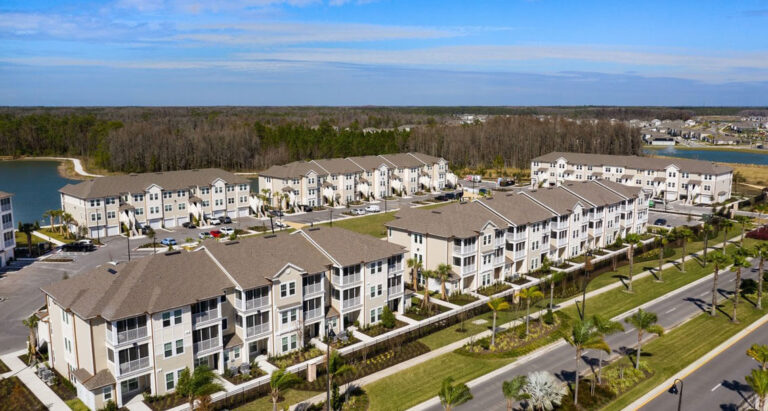 Residential
Residential
Pier 8 at The Preserve
A luxury apartment community in suburban Tampa
 Office
Office
222 Exhibition Street, Melbourne
An award-winning, showpiece office tower in Australia’s second-largest city
 Office
Office
2020 K Street
A downtown Washington office property with strong sustainability credentials



Important information
This webpage is for informational purposes and to give a general overview of LaSalle Investment Management. This webpage does not constitute an offer to sell, or the solicitation of an offer to acquire any interests in any collective investment vehicle, arrangement, entity, joint venture, club, separate account mandate or for the advisory services of LaSalle Investment Management or its affiliates. Should an interest in any of the foregoing be offered by LaSalle Investment Management or the services of LaSalle Investment Management be made available, then such offer or services will only be made available following the registration, authorization, license or other form of notification pursuant to the rules of the relevant country being obtained or otherwise satisfied. You are responsible for obtaining your own legal and tax advice in respect of any investment.
Important information about sustainability and LaSalle custom accounts
A decision to invest should consider all characteristics or objectives disclosed in the offering document. Please refer to the offering document, where applicable, before making any final investment decision.
Except where specified either in this webpage or any other documents, any sustainability or impact goals, targets, commitments, incentives, initiatives or outcomes referenced in any information, reporting or disclosures published by LaSalle are not being marketed to investors or promoted and do not bind any investment decisions made in respect of, or the management or stewardship of, any funds managed by LaSalle for the purposes of Regulation (EU) 2019/2088 on sustainability-related disclosures in the financial services sector. Any measures in respect of such sustainability or impact goals, targets, commitments, incentives, initiatives or outcomes may be overridden, may not be implemented or may not be immediately applicable to the investments of any funds managed by LaSalle (in each case, at LaSalle’s sole discretion).
Important information about assets held within custom accounts at LaSalle
The assets presented are meant for illustrative purposes only, are subject to change without notice and are not meant as a projection or estimate of the nature of any future investments to be made or returns on any such investments. This information has been prepared by LaSalle in order to illustrate the type of assets held and/or transactions completed within various custom accounts; transactions for properties exhibiting the same or similar characteristics may not be available or profitable in the future.
FOR INTENDED INSTITUTIONAL INVESTORS ONLY – NOT FOR GENERAL PUBLIC DISTRIBUTION
LaSalle Encore+’s pan-European, location-based strategy is centered around investing in desirable assets in the places where people live, work, shop, and play, both today and into tomorrow.
€ 0b
GAV
€ 0b
NAV
0
properties
0-star
GRESB rating
As of December 31, 2024; assets in euros. Returns may increase or decrease as a result of exchange rate fluctuation. Please see information regarding GRESB ratings at the bottom of this page.
As a core plus fund, LaSalle Encore+ aims to provide investors with consistent capital growth and stable, long-term income returns. The Fund was designed with the aim of providing attractive, risk-adjusted returns and a reliable income stream.
The Fund’s core team of 10 investment professionals is supported by a wider team of over 100 individuals* overseeing transactions, finance, investor relations, tax, legal and compliance across LaSalle’s six European offices.

The Fund management team’s long-term thinking has provided robust returns over the life of the fund, which has spanned both the Global Financial Crisis of 2008 and the Covid-19 pandemic. Please note that past performance does not predict future returns.

LaSalle Encore+’s assets are diversified across all major property sectors with the aim of providing reliable income.

Our asset management team plays a key role in our strategy to generate returns for the LaSalle Encore+ portfolio. By overseeing improvements to the Fund’s assets, they seek to mitigate downside risk and aim to unlock income and value.

The LaSalle Encore+ team works hand-in-hand with our research colleagues, whose recommendations and insights help to develop the Fund’s investment strategy.
For a full description of the risks associated with investing in the Fund, please refer to the “Summary of Risks” the offering memorandum.

Every day, the LaSalle Encore+ team works to improve the long-term environmental performance of the Fund’s assets. We work closely with tenants to understand their energy needs and help them meet their own commitments.
By working together to improve energy efficiency, lower emissions and capture resources such as sunlight and rainwater, we’re working to improve performance today and build a better tomorrow.
 Industrial
Industrial
Isle d’Abeau, France
A new-build asset located along France’s “logistics backbone” with good access to population centers in three countries
 Office
Office
Kennedytoren, Eindhoven
A multi-tenant office tower with high sustainability credentials in Eindhoven, The Netherlands.
 Industrial
Industrial
Tigery, Lyon
A new-build logistics warehouse southeast of Paris with access to the A5 Autoroute and the Francilienne (Paris ring road)
 Office
Office
Trí, Munich
Two prime office buildings in Munich’s vibrant Westend



Important information
This webpage is for informational purposes and to give a general overview of LaSalle Investment Management. This webpage does not constitute an offer to sell, or the solicitation of an offer to acquire any interests in any collective investment vehicle, arrangement, entity, joint venture, club, separate account mandate or for the advisory services of LaSalle Investment Management or its affiliates. Should an interest in any of the foregoing be offered by LaSalle Investment Management or the services of LaSalle Investment Management be made available, then such offer or services will only be made available following the registration, authorization, license or other form of notification pursuant to the rules of the relevant country being obtained or otherwise satisfied. You are responsible for obtaining your own legal and tax advice in respect of any investment.
Notice to recipients in the EU: With effect from the fund being registered for “marketing” pursuant to the provisions of Directive 2011/61/EU of the European Parliament and of the Council of 8 June 2011 on Alternative Investment Fund Managers (as amended), this webpage constitutes a “marketing communication” for the purpose of the “Guidelines on marketing communications under the Regulation on cross-border distribution of funds” (effective 2 February 2022) as issued by the European Securities and Markets Authority pursuant to Article 4(6) of Regulation (EU) No 345/2019). Please refer to the offering memorandum and management regulations of the Fund before making any final investment decision.
The Fund is actively managed.
Important information about sustainability and the LaSalle Encore+
A decision to invest in the Fund should consider all characteristics or objectives disclosed in the offering document. Please refer to the offering memorandum and management regulations of the Fund before making any final investment decision.
Except where specified either in this webpage or any other documents, any sustainability or impact goals, targets, commitments, incentives, initiatives or outcomes referenced in any information, reporting or disclosures published by LaSalle are not being marketed to investors or promoted and do not bind any investment decisions made in respect of, or the management or stewardship of, any funds managed by LaSalle for the purposes of Regulation (EU) 2019/2088 on sustainability-related disclosures in the financial services sector. Any measures in respect of such sustainability or impact goals, targets, commitments, incentives, initiatives or outcomes may be overridden, may not be implemented or may not be immediately applicable to the investments of any funds managed by LaSalle (in each case, at LaSalle’s sole discretion).
LaSalle Encore+ received a GRESB rating in October 2024, covering the period from January to December 2023. LaSalle pays a membership fee to GRESB.
Sustainable Finance Disclosure Regulation (SFDR)
If you are an investor or prospective investor in LaSalle Encore+, please log in to the Investor Portal or Dataroom to access the SFDR disclosures. If you do not have access, please Contact Us.
In accordance with its offering memorandum, the LaSalle Encore+ properties are valued monthly on RICS International Valuation Standards basis by Cushman & Wakefield and CBRE.
Important information about LaSalle Encore+’s portfolio of assets
The assets presented are meant for illustrative purposes only, are subject to change without notice and are not meant as a projection or estimate of the nature of any future investments to be made by the Fund or returns on any such investments. This information has been prepared by LaSalle in order to illustrate the type of assets held and/or transactions completed by the Fund; transactions for properties exhibiting the same or similar characteristics may not be available or profitable in the future.
LaSalle’s investments in Chinese logistics are part of a value-add strategy that aims to capitalize on the growing market for logistics facilities across the country.
The China logistics investment strategy consists of building a diversified portfolio of modern logistics facilities in selective markets with strong fundamentals across the country. The strategy is focused on capturing attractive development margins, while also seeking to acquire and reposition undercapitalized and undermanaged logistics assets. The strategy also invests in or convert existing warehouses into cold chain logistics to capture the strong and rising demand in this sector in China.

China’s modern warehouse sector is anchored on the country’s large population and economic base and its long-term fundamental growth drivers. The ongoing structural changes in China and the rapid growth of e-commerce also create potential for a favorable risk-adjusted return profile.

We rely on a robust in-house market analysis framework to evaluate 66 major cities in China based on factors such as growth potential, transportation connectivity and government support. Through our disciplined approach to location selection we aim to minimize leasing risk and invest in stable projects.

The team comprises more than 20 professionals and a senior team with 20 years of experience, sourcing off-market deals through programmatic joint ventures with local partners.

The ability to harness and synthesize information is key to the success of the China logistics investment team, which regularly draws on the expertise of LaSalle’s data-driven, in-house Research and Strategy team in setting strategy and making investment decisions.
For a full description of the risks associated with investing in any investment opportunity, please refer to the “Summary of Risks” the relevant offering memorandum.

At LaSalle, we are addressing the physical and transitional risks associated with the impacts of climate change and the move to a decarbonized world, with action across all areas of our business. When properly applied, we recognize sustainability criteria can positively influence investment performance.
Within the scope of our fiduciary duty, we use a tailored approach to each asset and portfolio, with each designed to protect and enhance financial returns, today and in the future.


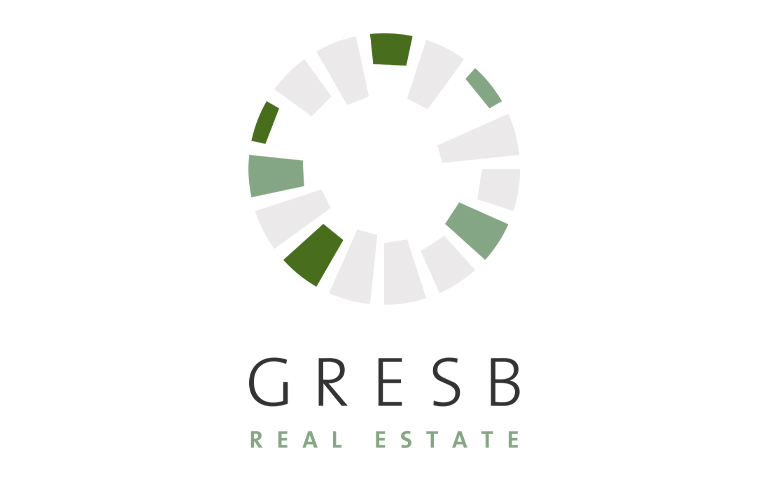
Important information
This webpage is for informational purposes and to give a general overview of LaSalle Investment Management. This webpage does not constitute an offer to sell, or the solicitation of an offer to acquire any interests in any collective investment vehicle, arrangement, entity, joint venture, club, separate account mandate or for the advisory services of LaSalle Investment Management or its affiliates. Should an interest in any of the foregoing be offered by LaSalle Investment Management or the services of LaSalle Investment Management be made available, then such offer or services will only be made available following the registration, authorization, license or other form of notification pursuant to the rules of the relevant country being obtained or otherwise satisfied. You are responsible for obtaining your own legal and tax advice in respect of any investment.
Important information about sustainability
A decision to invest in any investment opportunity should consider all characteristics or objectives disclosed in the offering document. Please refer to the offering documents relating to the relevant investment opportunity before making any final investment decision.
Except where specified either in this webpage or any other documents, any sustainability or impact goals, targets, commitments, incentives, initiatives or outcomes referenced in any information, reporting or disclosures published by LaSalle Investment Management are not being marketed to investors or promoted and do not bind any investment decisions made in respect of, or the management or stewardship of, any funds managed by LaSalle Investment Management for the purposes of Regulation (EU) 2019/2088 on sustainability-related disclosures in the financial services sector. Any measures in respect of such sustainability or impact goals, targets, commitments, incentives, initiatives or outcomes may be overridden, may not be implemented or may not be immediately applicable to the investments of any funds managed by LaSalle Investment Management (in each case, at LaSalle’s sole discretion).
FOR INTENDED INSTITUTIONAL INVESTORS ONLY – NOT FOR GENERAL PUBLIC DISTRIBUTION
The LaSalle Canada Property Fund invests in and manages a portfolio of assets focused on Canada’s six largest markets.
$ 0b
GAV
$ 0b
NAV
0%+
occupancy rate (core)
0-star
GRESB rating
As of December 31, 2024; assets in Canadian dollars. Returns may increase or decrease as a result of exchange rate fluctuation. Please see information regarding GRESB ratings at the bottom of this page.
The LaSalle Canada Property Fund is comprised of a diversified portfolio of assets primarily in industrial, multi family, office and retail with a secondary focus on niche and build-to-core sectors. The Fund’s management team is based in Canada and supported by a Canadian research team and the broader LaSalle Americas real estate platform with the aim of delivering value and maximizing long-term returns.

Canada is of the few top-rated sovereign markets with a sizable, transparent real estate market, with income yields being attractive compared to sovereign bonds. Demographic changes of strong population growth, a highly educated workforce and a service-oriented economy point to continued demand.

The Fund’s assets are diversified across all major property sectors and across major Canadian markets, including Toronto, Montréal, Vancouver, Ottawa, Calgary and Edmonton to which aims to provide reliable returns.

Toronto and Vancouver-based asset managers are within a day’s reach of all major Canadian markets. They play a key role in our strategy to generate returns from our assets. By suggesting and managing improvements to the buildings the Fund owns, they seek to mitigate downside risk and aim to unlock income and value.

The Fund’s Investment Managers work hand-in-hand with LaSalle’s Research and Strategy Team, helping to develop the Fund’s investment strategy and make sound transactional decisions.
For a full description of the risks associated with investing in the Fund, please refer to the “Summary of Risks” the offering memorandum.

The LaSalle Canada Property Fund’s five-star GRESB rating only conveys a small part of our commitment to sustainability; the Fund’s Airport Square property was one of the first ever office buildings in Canada to achieve Energy Star certification, and 100% of the Fund’s office and industrial holdings are LEED or BOMA BEST certified.
By working to improve energy efficiency, lower emissions and capture resources such as sunlight and rainwater, we’re working to improve performance today and build a better tomorrow.
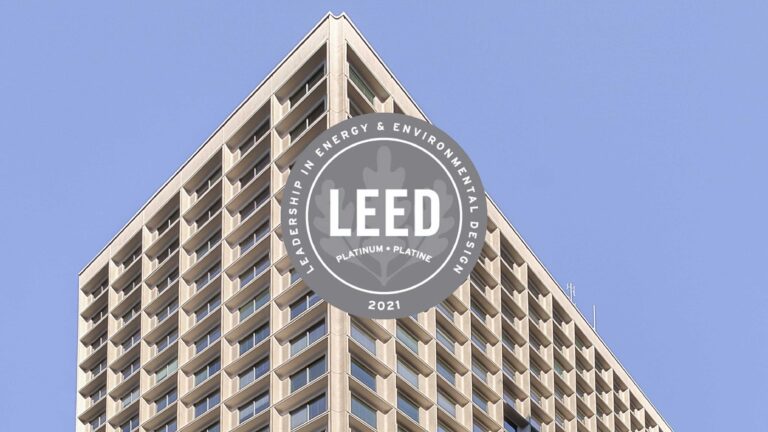 Office
Office
275 Slater, Ottawa
A revitalized office building in Ottawa’s central business district.
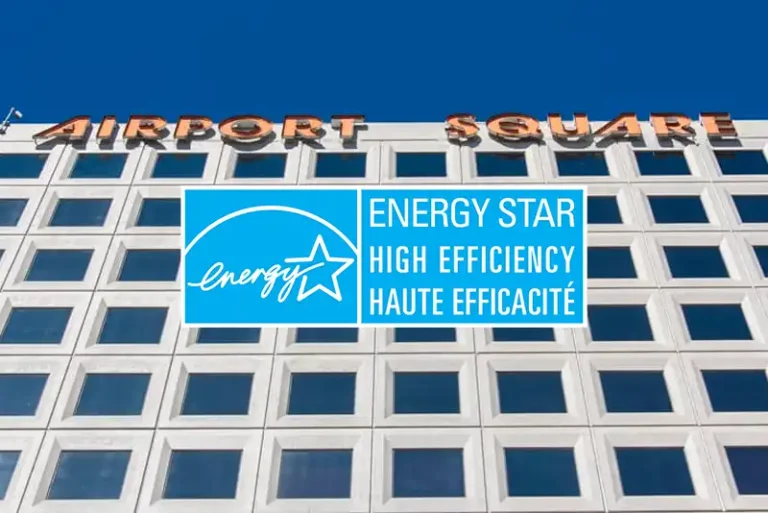 Office
Office
Airport Square, Vancouver
A South Vancouver office tower with strong environmental credentials
 Retail
Retail
Guildford Town Centre
One of Canada’s most productive shopping centers in a rapidly growing area
 Office
Office
Maison Manuvie, Montréal
An award-winning office building in downtown Montréal with strong environmental credentials.
 Residential
Residential
Rideau & Chapel, Ottawa
A new-build residential and retail development in the heart of Canada’s capital
 Industrial
Industrial
Toronto Industrial Portfolio
Strategically located warehouse facilities serving the Greater Toronto Area



Important information
This webpage is for informational purposes and to give a general overview of LaSalle Investment Management. This webpage does not constitute an offer to sell, or the solicitation of an offer to acquire any interests in any collective investment vehicle, arrangement, entity, joint venture, club, separate account mandate or for the advisory services of LaSalle Investment Management or its affiliates. Should an interest in any of the foregoing be offered by LaSalle Investment Management or the services of LaSalle Investment Management be made available, then such offer or services will only be made available following the registration, authorization, license or other form of notification pursuant to the rules of the relevant country being obtained or otherwise satisfied. You are responsible for obtaining your own legal and tax advice in respect of any investment.
Notice to recipients in the EU: With effect from the fund being registered for “marketing” pursuant to the provisions of Directive 2011/61/EU of the European Parliament and of the Council of 8 June 2011 on Alternative Investment Fund Managers (as amended), this webpage constitutes a “marketing communication” for the purpose of the “Guidelines on marketing communications under the Regulation on cross-border distribution of funds” (effective 2 February 2022) as issued by the European Securities and Markets Authority pursuant to Article 4(6) of Regulation (EU) No 345/2019). Please refer to the offering memorandum of the Fund before making any final investment decision.
LaSalle Canada Property Fund (Europe) is only being marketed to investors located in the EEA. LaSalle AIFM Europe S.à r.l. is the AIFM of LaSalle Canada Property Fund (Europe). Please refer to the pitchbook for more information in respect of this. The information provided on this webpage does not constitute any advice, offer, solicitation or recommendation to invest in specific investments. It is subject to change, is not legally binding and does not create contractual obligations. This webpage cannot be used as the sole basis for an investment decision or subscription in the LaSalle Canada Property Fund (Europe) presented or to which reference is made on an ancillary basis. Please refer to the Important Notice to Potential Investors Located in the European Economic Area included in the pitchbook for more information.
The Fund is actively managed and the Fund’s performance is not measured against any benchmark.
Important information about sustainability and the LaSalle Canada Property Fund
A decision to invest in the Fund should consider all characteristics or objectives disclosed in the offering document. Please refer to the offering memorandum of the Fund before making any final investment decision.
Except where specified either in this webpage or any other documents, any sustainability or impact goals, targets, commitments, incentives, initiatives or outcomes referenced in any information, reporting or disclosures published by LaSalle are not being marketed to investors or promoted and do not bind any investment decisions made in respect of, or the management or stewardship of, any funds managed by LaSalle for the purposes of Regulation (EU) 2019/2088 on sustainability-related disclosures in the financial services sector. Any measures in respect of such sustainability or impact goals, targets, commitments, incentives, initiatives or outcomes may be overridden, may not be implemented or may not be immediately applicable to the investments of any funds managed by LaSalle (in each case, at LaSalle’s sole discretion).
The LaSalle Canada Property Fund received a GRESB rating in October 2024, covering the period from January to December 2023. LaSalle pays a membership fee to GRESB.
Sustainable Finance Disclosure Regulation (SFDR)
If you are an investor or prospective investor in LaSalle Canada Property Fund, please log in to the Investor Portal or Dataroom to access the SFDR disclosures. If you do not have access, please Contact Us.
Important information about the LaSalle Canada Property Fund’s portfolio of assets
The assets presented are meant for illustrative purposes only, are subject to change without notice and are not meant as a projection or estimate of the nature of any future investments to be made by the Fund or returns on any such investments. This information has been prepared by LaSalle in order to illustrate the type of assets held and/or transactions completed by the Fund; transactions for properties exhibiting the same or similar characteristics may not be available or profitable in the future.
LaSalle provides a wide range of debt capital solutions throughout the capital structure to owners of commercial, residential and operational real estate. We lend on all major real estate asset classes throughout Western Europe including investment, development and transitional assets positioned in both core commercial as well as operational sectors.
While LaSalle is able to offer loans in a number of European jurisdictions, we cannot originate loans in countries which impose restrictions on alternative lenders. We are happy to provide more information upon request.
€ 0b
credit extended
0+
transactions
0
European countries
Data as of December 31, 2024


Senior-secured loans

Mezzanine finance

Development finance

Special situations



Private debt investors can benefit from being at the top of the capital stack and leverage LaSalle’s experience in connecting real estate investors to those seeking capital to finance their real estate projects.
Subject to legal and regulatory considerations, private debt investments at LaSalle are available through our specialty debt teams, the LaSalle Global Solutions platform, or as custom accounts.
European debt investments
LaSalle’s European debt platform is one of the continent’s most active investors in real estate debt
LaSalle Debt Investors
Investing in commercial real estate debt in growth markets across the US
LaSalle Global Solutions
Accessing global indirect real estate through public equities and private structured vehicles
Custom accounts
Fully customized portfolios suitable for larger investors


As the world slowly emerges from the worst pandemic since 1918, two of the most frequent questions we hear from investors are: “Will people return to cities? What can we learn from the Asia-Pacific experience?”
Although there are significant differences in the circumstances facing employers, workers, and consumers in each country, we believe it is quite helpful to understand what is occurring in the major cities of the Asia Pacific region as a preview of what might occur in the West. Behavioral influences play a large role. The sooner people are willing to return to their offices, the lower the potential impact on investment performance. Culturally, face-to-face meetings in a formal office setting are often viewed as essential business rituals in countries like China, Japan, and South Korea. In Shanghai, where the re-opening has been the most advanced globally, office demand turned positive in the second quarter of 2020. In Singapore, office demand (net absorption) turned positive in the fourth quarter of 2020, despite the worst economic decline since 1965 and the government’s policy capping office capacity at 50%. Even in the retail sector, which was hit harder by the pandemic than other sectors, occupier demand in Shanghai was positive in 2020. Chinese consumers gradually returned to malls when the health risk largely declined in April (see page 43).
The sooner people are willing to return to their offices, the lower the potential impact on investment performance.

The behavioral approach suggests that human psychology plays an important role in the decisions we make. A rational, fact-based approach to risk assessments and decision-making does not fully explain how people react to dangerous situations and their lingering fears after the danger has passed. The Asian experience seems to demonstrate that “recency bias” can be overcome through confidence-building actions and communications taken by governments and businesses. Despite cautious optimism, uncertainty lingers in major cities like Melbourne and Tokyo (see page 7). Nevertheless, it helps that mask-wearing is fully accepted and ubiquitous across most of the region. During times of uncertainty, behavioral influences on decision making are especially important. For instance, core beliefs, cognitive biases, past experiences, or cultural differences can influence decision making, which could ultimately affect economic and investment outcomes.
We believe the pandemic is a perfect example of why the behavioral approach matters. Asia Pacific’s ability to contain the pandemic is evident in traffic congestion and mobility indices (see pages 7 and 27). Rising mobility is a sign of rising confidence that builds into a virtuous cycle, when it becomes clear that leaving home while wearing a mask and social distancing–does not cause a resurgence of COVID. The pandemic control policies followed in major Asia Pacific countries, even before vaccine rollout, have a positive correlation with the region’s economic resilience, particularly in China, South Korea, Australia, and Singapore. The return of social and economic activities and real estate demand in Asia Pacific show what the West may be able to look forward to, as rising immunity levels in Europe and North America are likely to enable the same virtuous cycle of mobility and activity.
The rollout of COVID-19 vaccines will first help restore domestic activities, particularly in countries that were not able to control the spread of the virus in 2020– a critical step to repair their economies. Ultimately, for the global economy to reach the “new normal”, most likely a significant portion of the world population will need to be vaccinated. However, for now, the reality is that international border controls are getting stricter even in countries where vaccine rollouts have been the most advanced (e.g., the United Kingdom, in part, due to new strains of COVID-19); and in parts of the world that have been the most successful in controlling COVID-19, quarantine and social distancing rules remain stringent (e.g., Australia and Singapore) to ensure the momentum of the domestic recovery continues.
Looking forward, each country has a different vaccination rollout schedule and it could take some time for immunity to rise to levels that vastly reduce the risk of getting infected (see pages 6, 50). In the meantime, the upcoming economic and real estate recovery in most countries will rely more heavily on domestic demand. The experience of Asia Pacific shows us that a return to cities is not only possible, but probable, when both the behavioral and the biological effects of the coronavirus are tamed.